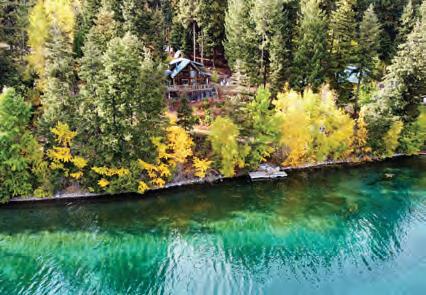

Flatlandbikes


















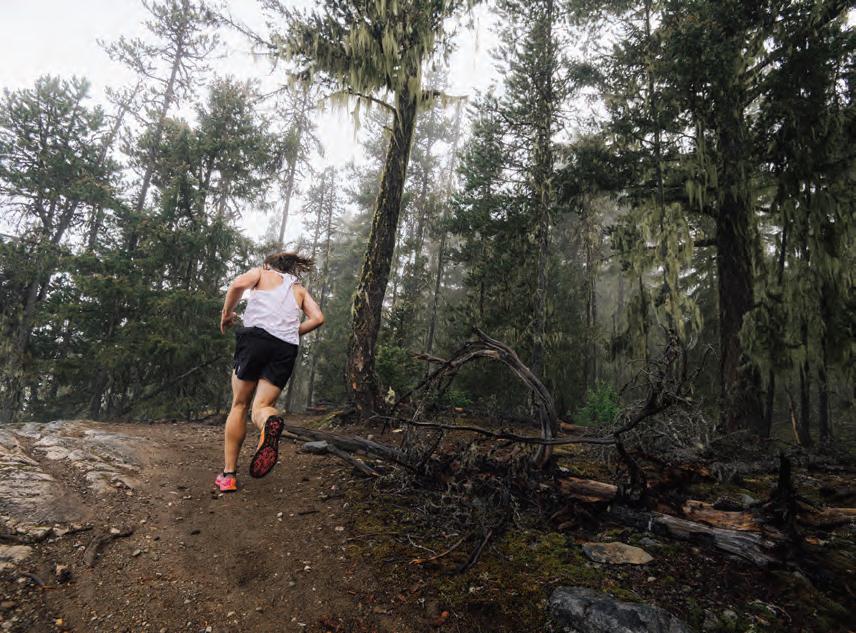
Flatland bikes on pirate trails


What Pemberton’s story reveals about the evolution of trail culture. - By Luke Faulks, Local Journalism Initiative Reporter
06 OPENING REMARKS Whistler is moving ahead with a ban on once-through cooling devices in the resort—but it really should have happened much sooner, writes editor Braden Dupuis.
08 LETTERS TO THE EDITOR In this week’s letters, readers weigh in on the future of the Whistler Racket Club and nation-building projects in Canada.
24 THE OUTSIDER Part 2 of Vince Shuley’s dispatch from a recent mountain-biking trip in the South Chilcotin Mountains.
46 PIQUE’N YER INTEREST As advertised, it’s finally here, writes Leslie Anthony. Fascism is back in all its full-blown peril.
10 GROWTH PRESSURES A new 30-year strategy outlines a potential $476 million in municipal facility upgrades in the resort by 2055.
12
LOOKING
BACK The Whistler Museum and Archives is marking Whistler’s 50th anniversary with a new exhibit looking at the Resort Municipality Act.
30 FOR THE GIRLS The Whistler Mountain Bike Park celebrates 20 years of Women’s Night with a special all-day event on Sept. 13.
34
THE
WRITE STUFF
The Whistler Writing Society’s annual general meeting is set for Sept. 25, featuring an open mic and a tribute to Whistler Writers Fest founder Stella Harvey.
COVER There was a time I was once known to get diggity diggity widit. - By Jon Parris - AdobeAI // @jon.parris.art
Publisher SARAH STROTHER - sstrother@piquenewsmagazine.com
Editor BRADEN DUPUIS - bdupuis@piquenewsmagazine.com
Sales Manager SUSAN HUTCHINSON - shutchinson@piquenewsmagazine.com
Production Manager AMIR SHAHRESTANI - ashahrestani@piquenewsmagazine.com
Art Director JON PARRIS - jparris@piquenewsmagazine.com
Advertising Representatives
TESSA SWEENEY - tsweeney@wplpmedia.com
ANDREW BUDRESKI - abudreski@piquenewsmagazine.com
Digital/Sales Coordinator KATIE DOUGLAS - kbechtel@wplpmedia.com
Reporters LIZ MCDONALD - emcdonald@piquenewsmagazine.com
LUKE FAULKS - lfaulks@piquenewsmagazine.com
DAVID SONG - sports@piquenewsmagazine.com
Office Manager HEIDI RODE - hrode@wplpmedia.com
Classifieds and Reception - mail@piquenewsmagazine.com
Contributors G.D. MAXWELL, GLENDA BARTOSH, LESLIE ANTHONY, ANDREW MITCHELL, ALISON TAYLOR, VINCE SHULEY, ALYSSA NOEL
Founding Publishers KATHY & BOB BARNETT www.piquenewsmagazine.com















































































































































The water we waste
IT’S FUNNY the random things we remember, sometimes.
Case in point: I am regularly reminded of an off-hand comment from a fellow student when I was living in the dorms at the University of Regina, many, many years ago—so long ago in fact I no longer remember the name of the guy who said it to

BY BRADEN DUPUIS
While running water at the communal sink, waiting for it to get cold enough for his liking, Scott cracked a joke about how he’s so fortunate to be able to waste so much water, and feels no guilt in doing so, even while so many in the world have none.
I didn’t think it was very funny at the time, but the words stuck with me—I’m reminded of them every time I run my Whistler tap until it’s cold, (as the Resort Municipality of Whistler recommends, to ensure our corrosive water hasn’t leached any metals into what I’m about to drink).
I’m reminded of them every time I see the water fountains at the Meadow Park Sports Centre running on an endless stream for the same reason.
And I was reminded of them again last week, when Whistler’s mayor and council finally advanced a bylaw to ban once-through cooling (OTC) systems in the resort.
For the uninitiated, OTC systems, commonly found in ice machines, walk-in coolers, air conditioners and other commercial
appliances, use a steady flow of drinking water to absorb heat before discharging it directly into the sewer.
If you’re feeling a sense of deja-vu, you’re not alone—the issue of OTCs was last broached nearly a decade ago, in 2018. At that time, after hearing concerns from the business community and hotel operators, council adopted a bylaw that banned new OTC units in the resort… 10 years after the date of adoption. So 2028.
The latest bylaw amendments, given first three readings at the Sept. 2 council meeting, bumped that deadline up, to prohibit new OTC installations after Dec. 31, 2025, and require all existing systems to be disconnected from Whistler’s potable water supply by Dec. 31, 2030.
It’s a prudent move, given how much drinking water the tech wastes. According to a staff report, a single small-to-medium OTC unit
But even with complete knowledge of how wasteful they are, and even with that original 2028 sunset clause fast approaching, staff noted in the latest update to council that OTC systems are still being installed in the resort.
One has to ask why this low-hanging, water-conserving fruit wasn’t addressed years ago—or better yet, why successive municipal councils didn’t have the spine to tell businesses and hotels “too bad.”
The issue has been on the municipal radar for decades. An Oct. 2, 2018 report to council noted OTC waste was identified as early as 2004, and a once-through cooling bylaw was brought before council in 2008 (it was not adopted).
It certainly won’t come cheap, but it’s unclear what the exact costs will be to businesses and hotels to move to alternatives (though many alternatives exist, such as closed-cycle cooling, dry cooling, geothermal,
bet they’ll be against. But that’s why we elect people, and not businesses, to make decisions for us.
In the time Whistler has spent dillydallying, other municipalities have acted: the City of Abbotsford (in 2017), and the City of Vancouver (in 2020) have both banned the tech already, while the Capital Regional District passed its own bylaw in 2016 to ban it by 2028.
According to the Sept. 3 staff report, businesses indicated in the latest round of engagement on this issue that they need three to five years to replace OTC systems. They cited funding limitations, strata-related decision-making processes, and uncertainty regarding municipal permitting requirements. More deja-vu. Shouldn’t local businesses have started preparing for this inevitability in, say, 2018?
It’s great to see the deadline moved up,
consumes about 1.6 million litres of potable water annually—enough to fill half an Olympicsize swimming pool. Another estimate found Whistler’s existing OTC systems use more than 54,000 cubic metres of treated drinking water every year—the equivalent of 34 Olympic-size swimming pools.
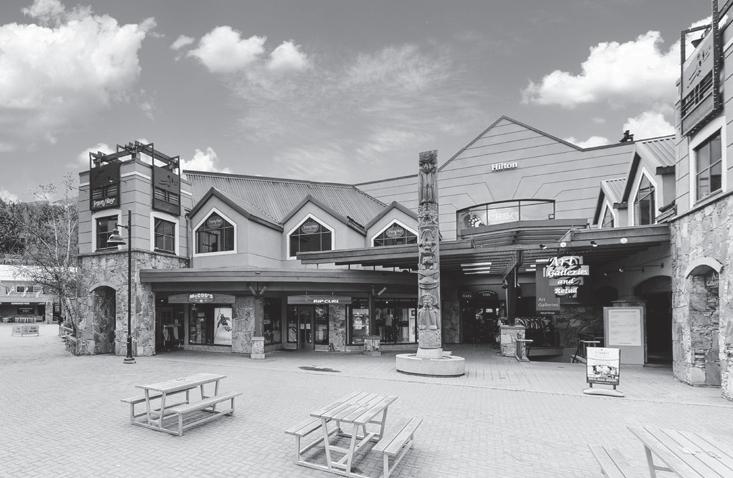

wastewater, etc.)—none of the previous staff reports on the matter include even a ballpark estimate of the cost to operators. Only that they are opposed to it.
Because of course they are. Businesses are always focused on the bottom line—anything that might impact that bottom line, you can


given the monumental water waste still going on in Whistler Village.
But it’s a damn shame the council of the day couldn’t give businesses the permitting requirement “certainty” they so desire way back in 2008, when this issue was first discussed at the council table. n
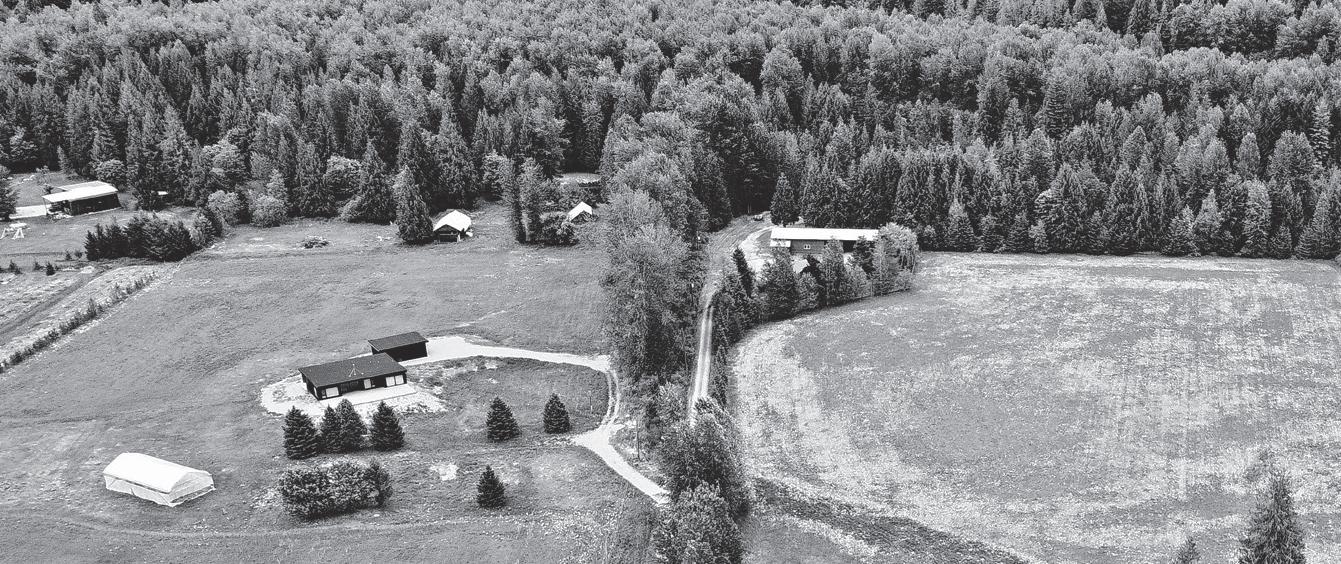






































WRC is ‘extremely important for human connection’
I wholeheartedly agree with Ms. Esther Gorman’s letter (see Pique, Aug. 22: “Allowing Whistler Racket Club to disappear ‘is not acceptable’”), as will thousands of people who have visited and played at the club.
It has always been a hub of activity and a great place to meet and socialize with others, which is important in an aging and increasingly family growing environment (we can’t all play frisbee golf).
Many of us agree that Whistler council needs to consider the mental health of young and old. We can’t have the youth attending bars more and if you take this away, the young and old will have fewer options and concerns with mental health and other more serious problems with substance abuse will develop.
Currently, families can connect and find good relationships with others to prevent the lack of connection. In this world of cell phones and media, these places are extremely important for human connection.
Sally John // Whistler
How can we encourage political leaders to think about future generations?
There is a lot of talk by our Liberal government

about “nation-building projects,” to be announced this fall as we are approaching the new federal budget.
How can everyday Canadians evaluate if these billion-dollar initiatives are in our interest or not? I think we and our leadership would do well to view these big initiatives through the lens of the Indigenous seven generations principle, which basically asks any big decision to be evaluated by “how will this choice affect my children, their children, and their children’s children?”
Science is telling us that global warming is changing the climate around the world with catastrophic consequences and that all nations on our Earth need to urgently reduce greenhouse gas emissions (GHG) to avoid the worst. Many nations are making big strides towards reducing emissions by building clean energy capacity, modern transport systems, new homes and public buildings that use less energy, electrifying personal and public transport—there are many great examples, especially in Europe, that we can learn from.
I believe, by applying the intergenerational principle of Indigenous nations, it becomes quite easy to evaluate the “nation-building projects,” yet to be defined and announced by our government. It most certainly cannot be to invest any public money into more fossil fuel infrastructure at a time when Canada has to do its part as a responsible member of the global community in reducing GHG emissions in line with our commitments made in the Paris Agreement.
There are so many examples of futureoriented national projects that people seven generations down the road will be proud of. High-speed rail and modern East-West electric transmission lines come to mind.
How can we encourage our political leaders to think about future generations rather than falling into the outdated “drill, baby, drill” trap like our neighbours to the south? Well, for one, we can contact our federal representative Patrick Weiler to send our message to Ottawa.
Erich Baumann, Pemberton
Protect the future of the Whistler Racket Club
For more than 30 years, the Whistler Racket Club (WRC) has been an important part of our community, offering accessible tennis, pickleball, and fitness opportunities for residents and visitors of all ages. It has long



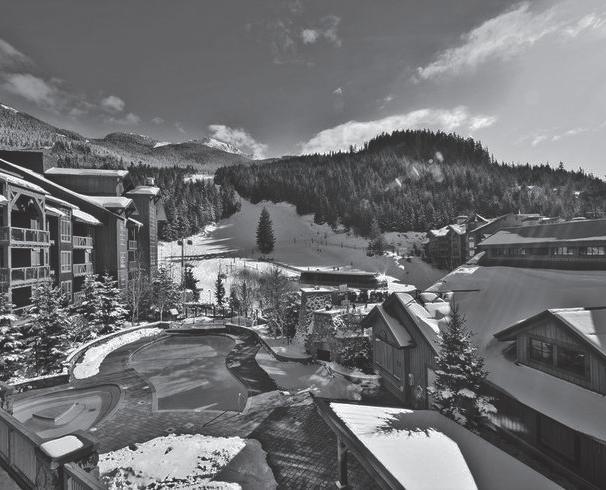



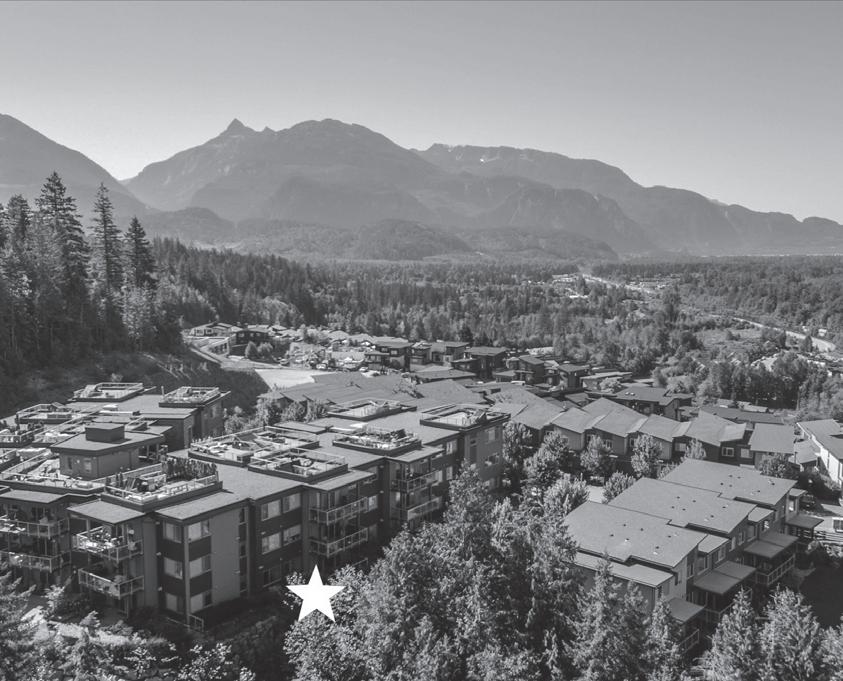


been a place where health, wellness, and social connection come together—qualities that make Whistler a vibrant and balanced place to live.
As a resident of Whistler for the past 14 years and a regular user of the facility, I have seen first-hand the benefits it provides. Thousands of locals rely on it, and its absence would leave a major gap in our recreation infrastructure.
Through recent rounds of public engagement, the community has been clear: two top priorities emerged—replacing the WRC with a multi-use racket centre and adding employee housing. The current proposal, however, achieves one at the expense of the other. While it provides for housing, it eliminates the WRC without any concrete plan, land, or funding to replace it. This disregards strong community feedback and sacrifices recreation in the process.
Yes, Whistler urgently needs more housing. But we must not achieve that goal by demolishing a facility that has served our community for decades. A true long-term vision must balance housing with recreation and well-being.
As plans for Northlands move forward, the replacement of the Whistler Racket Club should be a clear, actionable condition tied to any rezoning. The community deserves better than to see such a valuable facility disappear without a replacement in sight.
Diane Hanna // Whistler
LETTERS TO THE EDITOR
Willowcraft Farm shares thanks
It is with a heavy heart that Willowcraft Farm is announcing that we will no longer be vending at the Whistler and Pemberton farmers’ markets after this season’s end. We have attended these since their inception (30 years) and to have witnessed and be part of the transformation to what they’ve become now is remarkable.
Starting from a 20 x 30 tent in front of Chef Bernard’s and AG Foods (spearheaded by Nigel and Karen Protter), the words organic, localvore, permaculture and sustainable were not common and didn’t command a higher price. A successful market was one where we made enough to go out for dinner. Memories of barefooted hippies, unleashed dogs, naked babies and no food-safe standards are reminders of a different era, and the connections we’ve made over the years are cherished.
Hopefully we will have some more time to enjoy our summers and attend the markets as customers. We will still be homestead farmers, do gate sales, barter and perhaps do the odd pop-up because farming has never been our job, it’s been our lifestyle, and that will never change.
Thanks to all our loyal customers who’ve supported us through thick and thin (that’s farming). Please stop by and say hi/bye before thanksgiving.
Mike Roger and Suzanne Reimer // Birken/Whistler n

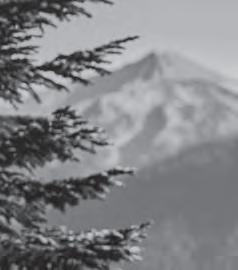
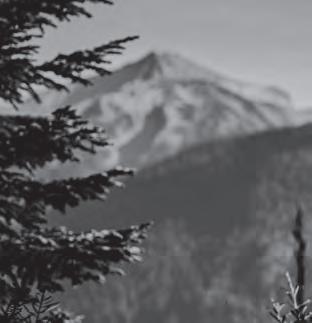












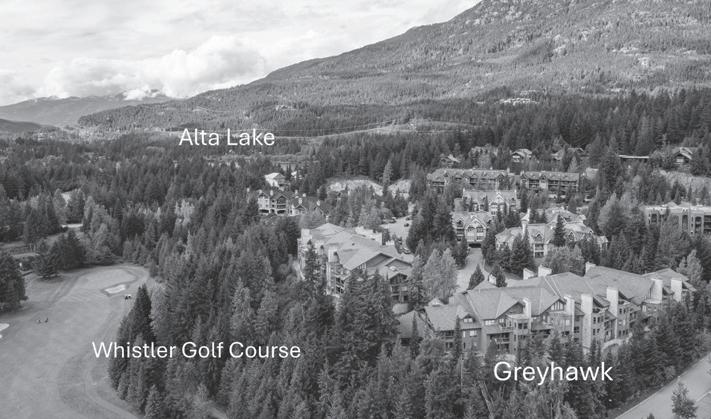





NickDavies, Whistlerlocal andexperiencedfamilylawyer practisingacrossBCandYukon. Callat 604-602-9000 or visit www.macleanlaw.ca
MacleanLawisheadquartered inVancouverwithofficesacross BritishColumbia.
Spacious 2bedroomcondo withlargewrap-around deckandmountainviews. NoGST. $1,625,000






Whistler weighs $476M in facility upgrades as growth pressures mount
A NEW 30-YEAR STRATEGY OUTLINES THE NEED FOR NEW FIRE HALLS, AN RCMP DETACHMENT AND EXPANDED RECREATION SPACE AS WHISTLER’S ‘POPULATION EQUIVALENT’ COULD SWELL PAST 77,000
BY LIZ MCDONALD
WHISTLER COUNCIL has been handed a sweeping, three-decade roadmap that anticipates nearly half a billion dollars in civic building investments—from a replacement RCMP detachment to expanded recreation space—designed to keep pace with a community expected to grow significantly by 2055.
The 30-Year Major Building Facilities Strategy, prepared by Cornerstone Planning with David Mitchell & Associates and BTY Group, takes stock of the municipality’s core buildings and tests their capacity against long-range population projections. The report concludes many facilities are either undersized today or nearing end-of-life and will need major renewal or complete redevelopment to maintain service levels as Whistler’s resident and visitor numbers rise.
“This is not a prescription,” general
manager of corporate services and public safety Ted Battiston told the committee of the whole on Sept. 2. “This is not a done piece of work. There is still quite a bit that needs to be done to really bring a more nuanced insight to the plans that this points towards.”
is that many of these facilities are about 40 years old now,” Battiston said. “If you project those out to the end of the study period… they would be 70 years old. Building codes have changed already considerably. The problems that many of these buildings are showing now would be far beyond end of life.”
“There is still quite a bit that needs to be done to really bring a more nuanced insight to the plans...”
- TED BATTISTON
SIX PRIORITY FACILITIES
The strategy concentrates on six facilities that anchor municipal service delivery: Municipal Hall and Annex, the Public Works Yard, the Public Safety Building (home to Fire Hall 1 and the RCMP detachment), Fire Halls 2 and 3, and the Meadow Park Sports Centre. These are the buildings that support administration, policing, fire response, public works operations and community recreation.
Many are already showing their age. “One of the things I want you to take away from this
GROWTH ON THE HORIZON
Using the Resort Municipality of Whistler’s (RMOW) Balance Model, the strategy applies three growth scenarios to Whistler’s “population equivalent”—a figure that blends permanent residents with temporary workers, second homeowners, commuters, day-trippers and overnight visitors. Even under the most conservative scenario, Whistler’s effective population rises to about 70,000 by 2055. In the medium case, it climbs to 77,183, while the high scenario tops 84,000.
Battiston reminded council that growth at those levels is not far-fetched. “The 25-year historic population increase in Whistler from 1999 to 2024 is 2.5 per cent,” he said, noting the medium forecast uses 2.1 per cent. “So it’s quite close to the high population forecast.”
WHAT THE STRATEGY FOUND
Municipal Hall is in relatively good condition, but by 2055 will require about 30 per cent more space if staff-to-population ratios remain constant. Digitizing paper records and reconfiguring interior layouts could buy time, but eventual expansion—or integration with a redeveloped Fire Hall 1—will be necessary.
The Public Works Yard, meanwhile, is hampered by inefficient layout and deteriorating structures. “It was never planned from a master plan perspective, and that really shows in its inefficiency,” Battiston said.
The RCMP detachment is already undersized. “We are slightly below the federal space requirements for a detachment of our size,” Battiston explained. “Rightsizing, staffing and vehicle needs over the next 30 years yields space needs that are more than double the current site size.” He added that “it is quite unlikely that both Fire Hall 1 and the RCMP detachment can in the long-term share that site,” suggesting
GROWING PAINS From Meadow Park to the RCMP headquarters, the next 30 years will require major upgrades to critical community infrastructure according to a recent consultant report presented to council.
PHOTO BY SCOTT BRAMMER / WHISTLER.CA
relocation toward the highway may improve response times as well.
Fire facilities tell a similar story. Fire Hall 2 is in “terrible shape” and must be replaced, Fire Hall 1 will eventually need redevelopment to a post-disaster standard with an integrated emergency operations centre, and Fire Hall 3—though in good condition today—will likely require expansion.
Recreation facilities are already struggling. Meadow Park operates at or near capacity, with non-ice, non-pool recreation square footage falling well below benchmarks. “Right now, we’re already short,” Battiston said. “And those populations project out for 30 years. Even if you had all of the spaces in the gyms and those other facilities, you would still be short.”
In aquatics, Whistler residents are among the heaviest pool users in the province. “Our community has a very healthy appetite for pool use,” Battiston told council. Meadow Park recorded nearly 12 swims per capita in 2024, compared with benchmarks of five in
expectations.
Councillor Arthur De Jong asked how remote work and artificial intelligence could reshape space needs. “Looking at the administration building, remote work, what has that done to date so far with respect to square footage needs? And then every report I read on AI … says it’s already happening, that AI is restructuring many components of our workforce,” he said.
Battiston acknowledged the uncertainty: “Projecting over 30 years is a really difficult thing to do, and you’ve got to start with what you do know, which is, how do we get here?” he said. “While that is likely a flaw … it does a good job of starting these important conversations.”
Coun. Jen Ford cautioned against treating the strategy as a promise. “I also see this teeing us up for a really difficult conversation with people who choose to cherry pick out the, ‘Oh, we’re getting a new rec facility in 2040,’” she said. “And I want to caution the community that this is a very high-level planning exercise.
“I want to caution the community that this is a very high-level planning exercise. This is not the wish list...”
- JEN FORD
Vancouver and seven in Burnaby. To maintain that service level, Whistler would require an additional eight-lane, 25-metre tank by 2055. If council is willing to see service drop to seven swims per person annually, the existing pool could suffice, but peak demand would remain a challenge.
The arena is similarly oversubscribed. “We already have latent demand of about 30 per cent,” Battiston reported. By 2050, those ratios suggest Whistler could fill a second sheet of ice.
PRICE TAG AND TIMING
In 2025 dollars, the consultants estimate the total program at $476.7 million. Roughly half of that—about $250 million—is for a new community recreation facility combining pool and arena space. Public Works modernization and yard redevelopment account for $92 million, fire halls about $57.5 million, and the RCMP detachment $47 million. Municipal Hall expansion would cost about $30 million.
If the entire package were financed through debt alone, Battiston warned, “this would represent an incremental tax requisition of around just over five per cent per year for each of the next 30 years.” He stressed that scenario is unlikely: “That is no grants, no sources of funds in any other way, if it was all just debt-financed—which, again, we wouldn’t do. But it gives a sense of the scale of the thinking that’s going to need to go into the long-term capital plan.”
COUNCIL REACTS
Councillors used the meeting to probe assumptions and temper community
This is not the wish list, nor is it the, ‘this is what we’re going to do,’ because there’s so many variables.”
Mayor Jack Crompton pushed the conversation toward land-use and financing. “Whistler is an interesting place to have a public safety building right in the middle of a village,” he said. “It seems to me that there’s some sort of real-estate valuation and financing conversations that may be more important than grants.
“It’s probably the right time to think deeply about how you’re going to use your assets well, especially when we’re talking about $500 million of constructed potential down the road.”
Other councillors raised regional concerns, noting Meadow Park serves families from Pemberton and Black Tusk and that Fire Rescue supports WedgeWoods. “If there’s gonna be that many people, that’s more grocery stores ... it’s more of everything, and where is the real estate for that coming from in the valley?” Coun. Ralph Forsyth said.
WHAT COMES NEXT
Staff recommended council formally receive the strategy and include work on a long-term facilities capital plan in the upcoming fiveyear financial plan. That plan will refine service levels, prioritize projects and identify funding options.
As Battiston summed up: “To provide service to that community of the future— which is 24,000 permanent residents, not 16,000 permanent residents—you’re going to need probably some additional facilities. Thinking that through is worthwhile planning, and it’s work we should be doing.” n






4 4.5 SQFT:3,511
$4,799,000
•Brightsouth west viewsona 20,000sqft+lot
•Vaulted ceilingsandexpansive windows
•Designedwithseamless flowandtimeless elegance
•Every detailthoughtfullyappointed






Whistler Museum marks 50 years since Whistler became Canada’s first resort municipality
NEW EXHIBIT EXPLORES THE BIRTH OF THE RMOW AND THE LEGACY OF A PIONEERING GOVERNANCE MODEL
BY LIZ MCDONALD
FIFTY YEARS AGO, Whistler was little more than a sleepy community clustered around Alta Lake, grappling with a future it could not yet imagine. By 1975, pressure from rapid development and surging ski tourism forced provincial officials to try something unprecedented: create a new category of local government. With the passage of the Resort Municipality of Whistler (RMOW) Act, Whistler became the first municipality of its kind in Canada—a legislative experiment that would forever change the community’s trajectory.
That bold step is now the subject of a new Whistler Museum exhibit marking the RMOW’s 50th anniversary. As the museum’s staff explained, the idea was to use this milestone to reflect on how and why Whistler was created as something fundamentally different.
“It was the first of its type in Canada … this community’s development was groundbreaking. Nothing like it had existed before,” said Bradley Nichols, executive director and curator of the Whistler Museum and Archives.
AN UNLIKELY BEGINNING
Whistler’s path to incorporation as a resort municipality was far from smooth. By the late 1960s and early 1970s, the area’s potential as a ski destination had become clear, but it lacked a formal government structure to oversee growth. Roads were rough, services minimal, and yet thousands of skiers poured into the valley every winter weekend. With only a few hundred permanent residents, the tax base was far too small to pay for the infrastructure that such an influx required.
In 1974, the provincial government responded with a dramatic move: it froze development in the valley until a more sustainable planning model could be designed. The result was the Resort Municipality of Whistler Act, which came into force in September 1975. Whistler officially became the Resort Municipality of Whistler, governed by a council that was expected to represent not only the permanent residents but also the broader needs of the tourism economy.
In that first municipal election, roughly 80 per cent of Whistler’s small population turned out to vote. It was an ambitious gamble: creating a governance model tasked with balancing the interests of locals and the demands of an industry that was already outpacing the town’s capacity.
BUILDING A RESORT TOWN
The museum’s exhibit delves into this history through archival photographs, original documents, and curated displays. Museum staff collaborated on the research, layout, and storytelling, conscious that many visitors might not realize just how unusual Whistler’s creation was.
“It was the first of its type in Canada...”
- BRADLEY NICHOLS
The RMOW model allowed Whistler to collect revenues from tourism-related activities, funnelling them into infrastructure and services that would otherwise have been impossible for such a small resident base. This structure gave the community the ability to manage everything from sewage treatment and waste collection to parks planning and recreation facilities—all with the dual mandate of serving both locals and visitors.
Five decades later, Whistler has grown into a thriving, year-round resort community
with more than 16,000 permanent residents and millions of annual visitors. But the tensions present in 1975 are still very much alive today.
“Tourism still pays for a lot of the infrastructure of Whistler,” Nichols said. “The people on the first council knew there was always going to be this push and pull— community versus tourism, and how to balance those two aspects. That’s still what our government here has to deal with.”
Over the years, Whistler’s resort municipality model has influenced other B.C. communities looking for ways to manage the strain of seasonal populations, from ski towns to coastal resorts. The RMOW Act demonstrated that tourismdriven municipalities required tools beyond traditional taxation and governance, paving the way for new provincial approaches.
But perhaps Whistler’s greatest legacy lies in how the Act cemented the valley’s identity: not simply as a ski hill or a bedroom community, but as a municipality built around the idea that a resort could also be a place to live, raise families, and cultivate a year-round culture.
The exhibit opened Sept. 6 and runs until Nov. 23. Find more info at whistlermuseum.org. n













Obituary –JoanElinorMarieDuguid
October30,1928 –August27,2025 "Lifeisfortheliving."
JoanElinorMarieDuguid(néeSilver)passed awaypeacefullyonAugust27,2025, at NorthShore Hospice,surroundedbyherfamily.Shewas96yearsold.
BornonOctober30,1928,inWinnipeg,Manitoba,toElsieandJohnSilver, Joangrewupin Brandonwithherthreebrothers.Onher18thbirthday,sheboarded atrainfor Vancouver— beginningtheadventurethat woulddefineherlife.





Joan’sprofessionalcareerbegan at ImperialOil,wheresherosefromthestenopooltobecome executiveassistanttotheCEObeforelaterjoiningtheHRteam.Shepausedhercareertoraiseherfamily, returningin1975foranother 15yearsofservice.
Aboveall,Joanwasdevotedtoherfamily. SheislovinglyrememberedbyherchildrenSusan, Tom(MaggieMorrison),andSharon(Bill Radvak);andbyhercherishedgrandchildrenLiam(Maty Fish),Tom,andEric Peiffer;AngusandCamDuguid;andEmmaandLaurel Duguid.Sheplayed apivotalroleinhelpingbothsetsofhertwingrandchildrenduringtheirprematureearlydays.Joanwasalsoa secondmothertomanyofherchildren’sfriendsand asteadypresenceinthelivesofherniecesandnephews,whoknewherasthe matriarchofthelargeSilver clan.
Joan’slifewasmarkedbyresilienceandjoy. Afterthetragiclossofherinfantdaughters,Lori(1959)andSandra(1961),sheadopted themotto,“Lifeisfortheliving.”Sheembodiedthiseveryday,pouringherenergyintoherchildren,community,andpassions. Aconsummatehomemakerandengagedmother,Joansewedeverythingfromskisuitstoquiltstoweddingdresses,prepared every mealfromscratch,andshuttledherchildrentocountlessactivities—BoyScouts,Brownies,fieldhockey,icehockey,skiing, swimming,sailing,andmore.Shewas aTawny OwlinBrownies, asewinginstructor,andanactivevolunteerinher West Vancouver community.Summerswerespentsailing,camping,andtripstotheOkanaganwithfamilyandfriends—waterskiing, swimming,and gatheringaroundcampfires.
Herloveofadventurewasendless.A competitiveskierinthe1940s,Joanracedacross WesternCanadaandtheU.S.Shemovedto Whistlerin1989,wheresheran asmallB&Bandvolunteeredas askihostfor30yearsonbothWhistlerandBlackcomb,becoming anhonorarylifetimepassholder.Herlastskiracewasatage65,wherehertimebestedmanyyoungercompetitors.Sheskieduntil age90andwaterskieduntil75.Joanalsolovedsailing,completingPowerSquadroncoursestosailsoloandwithfamilyaroundthe SalishSea.
Afterretiring,sheearned adiplomaintextileartsatCapilanoCollege,creatingbeautifulhand-spunandwovenworks.Shetraveled widely—backpackinginEurope,hikinginNewZealand,raftingtheStikineRiver,andsailingtheHebrides.Shealsoworkedasoffice managerandgroundstaffforaninternationalsailingtourcompany, oftenjoiningfortravelandsailingadventuresaroundtheworld. Joanwasknownforhervitality,fierceindependence,andpragmaticnature.Almostneverill,shecreditedherlongevitytodaily exercise,threesquaremeals,and aglassofmilk.EvenafterbreakingherlegoneChristmasEvewhileskiing,shestillcooked afull Christmasdinnerforfriendsandfamilybeforeseekingmedicalhelpthenextday.
PredeceasedbyherinfantdaughtersLoriandSandra;brothersDesmond,Gerry, andCecil;formerhusbandDonaldDuguid;andlaterin-lifepartnerKeithLord,Joanleavesbehind alegacyoflove,resilience,andspiritedliving. Inaccordancewithherwishes,therewillbenoformalservice.A privatefamilygatheringwillbeheld. Friendsandlovedonesareinvited toraise aglassinJoan’shonour,tocelebrate alifewelllivedandwellloved—andtocarryforwardhermotto:“Lifeisfortheliving.”





ReUse Whistler seeking local cafés to test-run new reusable cup program
THIS FALL, REUSABLE UPS CAN BE PICKED UP, REGISTERED TO A USER AND RETURNED AFTER USE TO PARTICIPATING BUSINESSES AROUND THE WHISTLER CORE
BY LUKE FAULKS Local Journalism Initiative Reporter
EVER TRY TO CRAM an extra coffee cup into an already-too-full garbage bin? Your woes may soon be over.
Starting this September, Whistler coffee drinkers will be able to sip from reusable, returnable cups instead of single-use disposables with the launch of a new pilot program aimed at curbing waste.
“Our goal is simple but ambitious: to replace single-use disposables with a new system for circularity in the community,” ReUse Whistler organizer Claire Ruddy told Pique. “The idea isn’t that people take them as souvenirs. It’s that they create a new system that works the same way as any plate in a restaurant—used, washed, and put back into circulation.”
The year-long pilot program, sponsored by WCS Engagement and Planning, is eyeing a mid-to-late September debut with coffee shops in the village core before expanding to other areas and businesses in a future phase.
While this marks the first organized reusable cup program for Whistler, there’s already a system in place. Ruddy and her team

are relying on a system from reusables.com. The company has worked with businesses and schools before on similar initiatives.
Here’s how it works: Customers ordering at a participating café will be able to check out a reusable cup with a quick scan at the till—either by tapping a card or using an app.
Cups can be used for free for up to five days and returned to any participating business. If
business owners.
She told council the plan is to continue expanding the program and displace as much waste as possible—and not just in cafés.
“The vision here is big, and we’re hoping to, over the next two to three years, add in more components to the program to include to-go food containers, making reusables available in hotels, offering an
“Our goal is simple but ambitious: to replace single-use disposables with a new system...”
- CLAIRE RUDDY
not returned, a charge is applied, though late returns are refunded.
A map of participating businesses will be rolled out as the program gets off the ground.
Ruddy said smart return bins for customers to drop off cups without having to go back into a participating store are planned for rollout closer to when Whistler Blackcomb opens later this fall.
All the while, Ruddy and her team will be tracking the cups’ circulation to help improve the program for customers and
alternative to disposables for events, golf courses, for community programs like [Whistler Community Services Society] and school lunches, and expand beyond the village core to the whole community and hopefully the corridor.”
Ruddy pitched the pilot program to Whistler’s mayor and council on Sept. 2.
Councillor Cathy Jewett pressed Ruddy on the program’s potential to reduce waste, noting Whistler already has specialized bins for coffee cups.
Ruddy acknowledged the specialized bins helped reduce the sort of contamination in other waste bins identified by a 2021 audit, but they don’t address the underlying issue.
“It doesn’t actually design out or proactively reduce the waste,” she said. “It’s just about trying to make it easier to manage.”
Coun. Arthur De Jong and Ruddy both connected the initiative to Whistler’s broader water conservation goals.
“Using 500 paper cups consumes nearly 370 gallons of water, whereas washing one ceramic cup 500 times consumes only 53,” she explained. “Coffee shops here go through up to 1,000 cups every morning. Reusables will beat single-use every time.”
Ruddy said the program is designed to make participation for businesses worthwhile. Early adopters will have access to a community stock of reusable cups at no cost, while saving on the costs associated with disposable cups.
“We think this is going to help build customer—and honestly, destination— loyalty,” she said. “There’s lots of brand value, marketing potential, but also a real financial case. Once you hit the break-even point, every additional cup reuse is just a win.”
Coffee shops interested in participating can schedule a demo, view sample cups, and choose a participation model at reusewhistler.ca. n
















More than 60 vehicles impounded on Sea to Sky highway despite warnings
RCMP BRIEFS: POLICE CONFIRM TWO SEPARATE FATAL INCIDENTS IN SEA TO SKY DURING HOLIDAY WEEKEND
BY JENNIFER THUNCHER Squamish Chief
PEOPLE JUST DON’T seem to learn.
A spokesperson for BC Highway Patrol says even after the agency put out repeated warnings about increased enforcement on the Sea to Sky highway, more than 60 vehicles were impounded for speed and impaired driving over the last week of August.
More than half of those impounds—31— happened over Labour Day weekend.
“There are still too many people driving unimaginably fast or impaired on the Sea to Sky,” said Cpl. Michael McLaughlin, of BC Highway Patrol, in a news release. “And while it’s hard to believe, we keep catching people doing both at the same time.”
One incident happened on Aug. 27, when a BC Highway Patrol motorcycle recorded a blue pickup driving 132 km/h in an 80 zone near Porteau Cove.
The driver, who the RCMP said was a 29-year-old Vancouver man, was given a breathalyzer test for alcohol impairment and blew two “warns.”
A warn means the person showed a bloodalcohol level over 50 milligrams of alcohol in 100 millilitres of blood, so over .05. A “fail” result means the person has a blood-alcohol level over .08.
This driver at Porteau Cove was given: A three-day driving suspension; an excessive speeding ticket under section 148(1) of the BC Motor Vehicle Act (MVA) for a fine of $368; a seven-day vehicle impound at his expense; and at least three years of high-risk driving premiums that will push the total cost of fines and fees to almost $2,500.
Another example of an incident logged by
under section 148(1) of the BC MVA ($368); a ticket for unnecessary noise for his aftermarket muffler, section 7A.01 of the BC Motor Vehicle Act Regulations ($109); and at least three years of high-risk driving premiums that will push the total cost of fines and fees to over $2,500.
“Traffic patterns and volumes are shifting with back-to-school, and weather and darkness are bigger factors every day,” said
“We’re encouraging you to slow down and plan for more time on the road. It shouldn’t need to be said, but you also need to stay sober.”
- MICHAEL MCLAUGHLIN
Mounties happened on Aug. 31, when a black Harley Davidson was recorded travelling 110 km/h in a 60 km/h zone at Lions Bay. The rider, a 61-year-old North Vancouver man, was given a breath test that led to two failure readings.
He received: A 90-day Immediate Roadside Prohibition (thus, losing his driver’s licence); a 30-day impound for the motorcycle; a ticket for excessive speeding


McLaughlin. “We’re encouraging you to slow down and plan for more time on the road. It shouldn’t need to be said, but you also need to stay sober.”
FATAL INCIDENTS
Labour Day weekend was a tragic one in the Sea to Sky corridor for the family and friends of two
men after two separate fatal incidents.
A spokesperson for Sea to Sky RCMPSquamish said on Sunday, Aug. 31, police were contacted about a missing man in the water at Porteau Cove at about 5:18 p.m., according to an RCMP release.
Members of Royal Canadian Marine Search and Rescue, the Coast Guard, BC Emergency Health Services, and Lions Bay Fire Rescue were able to locate the man, but he had died, the release stated.
On Sept. 1, a man died in a vehicle crash at approximately 9:30 p.m. on the highway between Squamish and Whistler.
Sea to Sky RCMP-Squamish, Integrated Collision Analysis and Reconstruction Service (ICARS), Squamish Fire Rescue, and BC Emergency Health Services responded to the crash involving a motorcycle and an SUV. The individual was declared deceased at the scene.
At this time, Mounties say no further details will be released as both matters remain under investigation.
While the RCMP release does not state the location of the crash, it matches a collision that closed the highway for several hours in both directions between the Alice Lake Provincial Park turn-off and Cat Lake on Monday night, Sept. 1.
“The Squamish RCMP extend condolences to the families and friends impacted by these tragedies,” the release said. n



No fatalities after ‘forced landing’ of BC Wildfire Service helicopter near Pemberton
BASTION PEAK
WILDFIRE NEAR
BY LUKE FAULKS Local Journalism Initiative Reporter
LILLOOET LAKE GROWS TO 530 HECTARES
THE BC WILDFIRE Service (BCWS) is reporting no fatalities or critical injuries after a helicopter working near a new wildfire on the slopes of Mount Currie/Ts’zil endured a forced landing.
B.C. Minister of Forests, Ravi Parmar, explained the incident occurred after the 0.009-hectare fire was spotted on the morning of Wednesday, Sept. 3.
“The helicopter was carrying an initial attack crew while responding to a wildfire located south of Pemberton,” he announced during a Sept. 3 wildfire update.
“I am relieved to let you know that all occupants are accounted for and there are no critical injuries. First responders agencies are on-site or en route and they will provide more updates as they come.”
Both Parmar and the Pemberton RCMP detachment asked residents to steer clear of the Airport Road area to provide room to first responders working at or travelling to the scene.
“I’m grateful for all the crews for all their work and in particular to the first responders supporting our wildland firefighters,” added Parmar.
In a general update on fire conditions, Parmar called for continued vigilance as





summer shifts to fall.
“Over the past week, parts of B.C. have seen record-breaking high temperatures with little to no rain around most of the province, coupled with over 6,000 lightning strikes that resulted in a sudden increase in the number of wildfires across B.C.,” Parmar told reporters.
“Let me be clear, the risk of new wildfire starts and week-over-week growth remains a serious issue for much of the province, and the immediate weather forecast will continue to create challenging wildfire conditions.”
As of Pique’s weekly deadline on Sept. 10,




a small handful of fires were burning in the corridor, mostly in the Pemberton area.
The Bastion Peak fire on the west shore of Lillooet Lake, southeast of Pemberton, was listed at 530 hectares as of Sept. 10. The out-ofcontrol fire is believed to be lightning-caused.
“The Pemberton area has benefited from recent rain. Approximately 25 mm of rain fell in the vicinity of the Bastion Peak Wildfire from Sunday night into Monday (Sept. 7 to 8),” the BC Wildfire Service said in a Sept. 9 update on the fire.
“Fire behaviour on the Bastion Peak today




was mainly Rank 1, a ground smouldering fire with no open flame. Debris falling downslope remains a safety hazard, whether caused by fire burning upslope or heavy rain.”
Crews spent Tuesday, Sept. 9 “mopping up” along the Green River Forest Service Road, the BCWS said.
“Objectives are to prevent the fire from crossing the road and reaching the lake. Helicopters based in the Pemberton zone are available to bucket on areas of heat when required,” it said.
“There has been recent growth on this incident, driven by dry fuels and slope. Upslope is not safe for ground crews due to terrain and other hazards.”
Two other out-of-control fires were also still burning near Pemberton on the morning of Sept. 10, including a 0.009-hectare fire on Mount Currie, discovered Sept. 3, as well as a 64-hectare blaze near Rutherford Creek. A 6.6-hectare fire north of the Soo River is now classified as under control. Further west, in the Elaho Valley, two massive fires have now become one, but are classified as being held at about 1,540 hectares.
Residents are encouraged to download the BC Wildfire app, set up notifications for local fire activity and report any new wildfires to *5555 or 1-800-663-5555.
Stay tuned to the BC Wildfire Map for the latest, and check back with Pique for updates. n


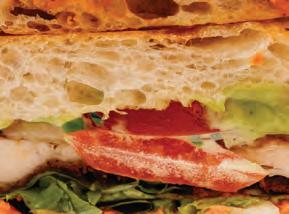




STEADY GROWTH The Bastion Peak wildfire measured 530 hectares as of Sept. 10.
PHOTO COURTESY OF THE BC WILDFIRE SERVICE

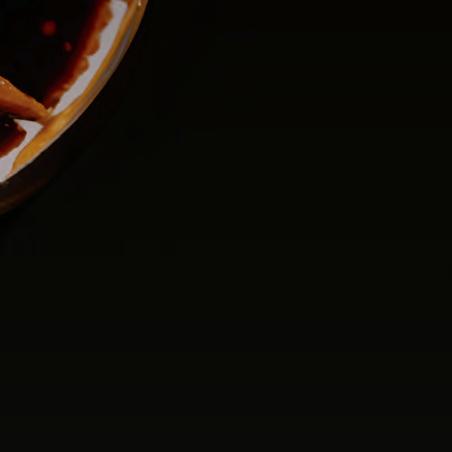









JAMES GARRY WATSON
SEPT. 3, 1933 - APRIL 5, 2023
The Resort Municipality of Whistler from time to time recognizes certain persons in the community who have contributed of themselves to help make Whistler a better place for all to enjoy.
The community recognizes these outstanding contributions by declaring them: “Freeman of the Resort Municipality of Whistler.”
BY G.D. MAXWELL
GARRY—I NEVER KNEW he had any other first name—was the second person honoured with the Freedom of the Municipality. His contributions to the development, success and maturation of Whistler are impossible to overstate. Without his determination, fearlessness, honesty, understanding how to get things done in a political environment and overarching commitment to public service, the Whistler story would possibly not be one of success but instead a dream that spiralled into bankruptcy.
Born in Stewart, B.C., rooted in Newfoundland and educated in Nova Scotia, Garry was a young lawyer making his home in Vancouver when he got involved with a group of local businessmen who, inspired by the 1960 Winter Olympics and frustrated with the lack of a first-class ski mountain close to Vancouver, formed the Garibaldi Olympic Development Association (GODA).
Garry saw the “community” needed to underpin that dream. While spending a weekend at a client’s logging camp near Alta Lake in June, 1961, he hiked to the top of London Mountain. “Looking down from the peak to the valley was one of the most startling experiences I’ve ever had,” he recalled. As well as the glistening lakes, he saw the community he wanted to live in.
It was a bold decision, rash perhaps, given there was nothing in the view to offer a career path forward for a 28-yearold lawyer. But Garry saw the possibilities and knew he’d found his home. He bought some land, built a cabin and waited for the community to catch up to his vision.
His first project with GODA was chair of its Community Planning Committee. After all, what’s a first-class ski mountain without a community to make it thrive? That effort laid the groundwork for what was to come.
GODA spawned Garibaldi Lifts Limited to assess the feasibility of developing London Mountain into a ski area. After evaluating the promise of the mountain and raising funds, work was started. Their efforts bore fruit and Whistler Mountain’s Creekside base opened a few years later.
Ski hill? Check. Town? Oh yeah, town. Initially a fringe part of the SquamishLillooet Regional District when that entity was formed in 1968, the nascent resort was saved from unbridled development when

the provincial government instituted a development freeze in 1974—excepting construction of single-family homes— and subsequently created the Resort Municipality of Whistler Act in 1975.
As part of that act, it established a local government, appointed one of the aldermen—Al Raine—and tasked the new body to create the first Official Community Plan (OCP) and imposed taxes on property owners to finance a community sewer system.
Garry was instrumental in all that. Serving on the first municipal council, along with John Hetherington, Raine, Bob Bishop and Mayor Pat Carleton, the “real work” began.
A key element of that work was the establishment of a single town centre, something to give a focus to the community. Council unanimously believed the best location was Crown land at the base of both Whistler and Blackcomb mountains. Blackcomb was years away from being developed and the only development on Whistler Mountain was down at Creekside.
While the council saw the benefit of siting the town centre on Crown land, thereby avoiding having to purchase costly private land and controlling all the land essential to the development of the town centre, local landowners disagreed.
An ad hoc group of property owners banded together to present a competing vision with the town centre located north of today’s village—on property owned by them—and made a forceful presentation to the province.
Garry tells the story of the mayor, Al Raine and himself travelling to Victoria
to meet with Hugh Curtis, Minister of Municipal Affairs, following the property owner’s group. They carried determination... and the resignations of the entire council, to be tendered if the minister didn’t agree with their plan to build Whistler Village at the base of the mountains.
They were relieved of that onerous outcome when the minister, referring to the competing landowners’ proposal, described it by saying, “You know, I never saw such a display of bullshit baffles brains in my life.”
It was a gutsy move. In later years, Garry described it as the Whistler Style: Be strong, be clear and don’t back down.
The disappointed property owners, failing to believe anyone could be inspired by other than self-interest, tried to make charges of conflict of interest and/or corruption stick. Neither did, although the RCMP officer investigating the latter, including tapping the phones of members of council, reported he had, “investigated many municipalities and never found one quite as lily white as Whistler.”
From the first OCP, to the development of the Whistler sewer system, to the planned design of the Village, to the so-called provincial bailout when interest rates threatened to bankrupt the partially built village, Garry was right in the middle of virtually every decision that made Whistler what it is today. He led the charge on many.
“He was the guy who knew how to get things done,” remembered Al Raine. “We had a lot of big-picture ideas. But it was
his expertise as a lawyer that understood how to get them done. Without him, a lot of those things never would have happened.”
One of those things Garry was passionate about was affordable housing for locals. While the council of the day in 1980 turned down a proposal by Doug Sutcliffe—one of the original village designers who had a background in social housing—to prepare a study to tackle the issue, Garry grasped the importance of affordable housing to the town’s success. Almost a decade later, he was hired by the RMOW as its employee housing coordinator. He later was executive director of the Whistler Valley Housing Society and succeeded in acquiring land and zoning for projects around town. He was still working on housing issues to the very end.
Garry never stopped working to make Whistler a better—not necessarily bigger—success until his death in April 2023. Collecting accolades along the way, including Citizen of the Year, a provincial Community Achievement Award, helping found the Chamber of Commerce and so many, many others, he remained uncommonly humble and always available to anyone who wanted to talk about ways to make this community better.
It was an honour to call him a friend.
This is Part 2 in a 16-part series recognizing Whistler’s Freedom of the Municipality holders, in honour of the Resort Municipality of Whistler’s 50th anniversary. Watch for the others in the weeks ahead, and find them all at piquenewsmagazine.com. n
PHOTO FROM THE WHISTLER QUESTION COLLECTION / COURTESY OF THE WHISTLER MUSEUM













TheResor tMunicipalityofWhistlerinvites applications fora memberpositionontheZero WasteWorkingGroup.Thepurpose oftheWorking Groupistoworkcollaboratively to implementthe strategiesandactionsoutlinedinWhistler’s Zero WasteActionPlan.
Applicationsarebeing soughtforone Member at Large fora two-yearterm.
ScantheQRcode to applyorformore informationabouttheWorkingGroup Termsof Reference.
Submissiondeadline: September22 ,2025at4 p.m.




New report lays out vision for Pemberton’s Hillside neighbourhood
THE CURRENT NEIGHBOURHOOD PLAN INCLUDES UP TO 450 NEW HOUSING UNITS IN PEMBERTON’S ‘LAST LARGE-SCALE TRACTS OF POTENTIAL DEVELOPMENT’
BY LUKE FAULKS
Local Journalism Initiative Reporter
THE VILLAGE OF PEMBERTON (VOP) has produced a draft Hillside Neighbourhood Plan that charts a path for up to 450 new homes and expanded recreation amenities on the community’s eastern slopes.
The report, presented to Pemberton’s Committee of the whole on Sept. 9, responds to three development applications in the Sunstone and Ridge neighbourhoods.
Staff said the plan is designed to “ensure the next stages of development support Pemberton’s current and forecasted housing needs,” while balancing environmental, cultural and infrastructure considerations.
THE
STORY SO FAR
The Hillside area has been earmarked for growth for nearly two decades.
In 2007, a Squamish-Lillooet Regional District (SLRD) study first identified the neighbourhood as a future residential expansion zone.
When the Village of Pemberton extended its boundaries in 2011, it amended its new OCP to include Hillside within the urban growth boundary. Parts of the land were rezoned to create today’s Sunstone and Ridge neighbourhoods, while the remainder was marked as a “Special Planning Area” requiring
further study before residential designation.
In 2023, the committee of the whole directed staff “to initiate a comprehensive neighbourhood planning process” for Hillside, citing the need to integrate new housing proposals with green space, commercial and recreation planning.
By 2024, council had received an outline of the plan and formally resolved to consult with the Lil’wat Nation, the SLRD, school districts, health authorities, recreation groups and others before advancing it further.
HOUSING OVERSUPPLY?
The plan identifies Hillside as “one of the last large-scale tracts of potential development land within the Village boundaries.”
Three major applications are already in play: the approved Parkside project (34 single-family residential lots with multiunit infill), the proposed Redwoods project (134 townhouses) and Sunstone Phase 4 (an expansion of 245 units over 36.9 hectares).
The report notes the up to 450 new housing units, combined with the Nkwúkwma/ Benchlands (400 units), downtown (120), and Gateway (500) developments, represent an oversupply compared to the Village’s projected 20-year need. Altogether, Pemberton has approximately 1,450 developments under application or recently reviewed, while the Village’s 20-year housing target shows 1,076 units needed.
Mayor Mike Richman expressed support for generating more supply of housing than what’s needed “on paper.”
“It seems to me that oversupply and the risk of having too many projects come
online at the same time, seems to be a smaller risk than not having those lands available,” he said.
VOP consulting planner Cameron Chalmers also downplayed the notion of an oversupply, given the timeline for new developments is always uncertain.
“The challenge is we know that a lot of the lands that have recently been approved are likely not going to proceed anytime soon,” he told council. “There’s so many unknowns about how the community is going to grow, even though on paper we’ve got a lot of those things figured out.
“The further you move away from urban municipalities, the less predictable some of these things become,” he added.
Anchoring the neighbourhood is the existing Rec Site—home to two soccer fields, the bike skills park and a new amenity building. Staff envision additional fields, a potential recreation centre building and new trail connections secured through developer contributions. But the plan doesn’t presuppose what the community and council might specifically choose to do with the area.
“The Rec Site should be considered as a community focal point and a mix of gathering places [and] active and passive spaces should be considered at the [site],” the report reads.
The plan also calls for a net gain in public trails, consultation with the Pemberton Valley Trails Association and aims to secure longterm public access across private lands.
AMENITY CONSTRAINTS
Councillor Ted Craddock said the lack of public transit options to the new development
made him reticent to fully support the suite of development proposals. He added the issue would be particularly acute for seniors, who might struggle to travel for access to key services in the Village’s downtown area.
“I’m more in favour of not creating a satellite community,” he said. “Because out there it becomes an issue. You’re going to have to have a vehicle, for lack of transit options. [So] I would prefer to see the in-town site developed first.”
Chalmers noted that, while the neighbourhood plan does not contain a guarantee of new public transit options, the increased densification of the area would represent a strong case for expanding transit services.
Coun. Katrina Nightingale highlighted the need for affordable housing, and asked how council could “ensure a certain amount of tenure is affordable within the context of all these developments.”
Chalmers noted the high number of development applicants in the new neighbourhood means the VOP can be “a little more rigorous in how [applications are] reviewed and a little more concentrated on fitting the project into the community,” including provisions for affordable housing and aging-in-place.
The plan is at the referral stage and will undergo consultation with the public, Lil’wat, and other stakeholder groups before returning to council for adoption. If approved, it would amend Pemberton’s Official Community Plan to formally designate Hillside as a residential growth area.
Staff are planning a public open house to discuss the neighbourhood plan in October. n
OVER THE HILL The new neighbourhood is situated east of Pemberton, framed by the Sunstone and Ridge developments.
$41K WBF grant brings drone to Pemberton Search and Rescue
DRONE EQUIPPED WITH THERMAL, MULTI-SPECTRAL SENSORS
BY LUKE FAULKS Local Journalism Initiative Reporter
PEMBERTON SEARCH and Rescue (PSAR) has added a Remotely Piloted Aerial System to its toolkit, thanks to a $41,000 grant from the Whistler Blackcomb Foundation.
The team told Pique the public-safety model drone, equipped with advanced optics, thermal imaging and multi-spectral functionality, represents a leap forward for its ability to search a vast and often unforgiving terrain.
PSAR president David MacKenzie said until now, they relied on outside agencies— often days into a search—to bring in drones.
“It’s usually not until we’re maybe into the second or third day into a search where these other agencies are then providing us the capability to bring in drones,” MacKenzie explained.
“So now we’re able to close the gap on time. If we have a type of search or a type of rescue that we’re undertaking at the time, we can execute the drone team immediately.”
He explained the purchase was made possible after provincial recognition of drones as a legitimate search-and-rescue (SAR) tool. A new provincial guideline from the Ministry of Emergency Management and Climate Readiness allows SAR groups to use drones and get the devices certified to fly under Transport Canada guidelines.
“It allowed us the ability to actually look at how we could acquire a drone. It’s an expensive piece of equipment [and] we needed to make sure we have the personnel that are properly trained and also licensed under this new capability,” MacKenzie explained.
“The Whistler Blackcomb Foundation provided us the opportunity. They recognized the work that we do in the corridor and they’ve been a very longtime supporter of Pemberton Search and Rescue.”
Drone team lead Michael Michalchuk echoed MacKenzie’s gratitude to the Whistler Blackcomb Foundation. Without the grant, Michalchuk said, the project wouldn’t have moved forward.
“It just physically wouldn’t have been brought to the table,” he said. “Never mind to vote on it. It just would be a non-starter.”
Michalchuk said PSAR’s drone program grew out of a smaller “proof-of-concept” device acquired last year. The trial drone proved its worth in training exercises like rope rescues, where it could go over the edge first and give the team an overview before rescuers were sent in.
“We got a smaller off-the-shelf drone [with] first-person goggles, the whole nine yards,” Michalchuk recalled. “I’d proposed it to the board just to show that we don’t have to necessarily send people into every scenario [like those] low-probability, high-risk areas.”
Pemberton SAR’s coverage area—25,000 square kilometres—is among the largest in the province, spanning lakes, cliffs, glaciers and alpine wilderness.
“A drone could be useful in a wide range of environments,” said MacKenzie. “Lake search, cliff faces, ice climbing situations, you name it.”
The upgrade also boosts PSAR’s value in mutual-aid situations.
“We provide assistance to both Whistler and Squamish. We’ve gone as far as Coquitlam and Kamloops,” MacKenzie said. “If we have an active search or an active task where they are looking for a drone team, that drone team could be an essential part of a mutual aid request.”
Only three PSAR members currently hold drone certification, but six more are working toward it. The unit’s two controllers allow pilots to hand off operations between positions— improving safety and operational reach.
The new drone dwarfs the test unit. It measures 18 inches propeller-to-propeller, weighs 3.7 pounds and has a dual hot-swappable battery system and IP68 waterproofing. It offers 200x zoom, multi-spectral infrared, a laser range finder, and advanced thermal imaging. Other gear includes a parachute for over-people operations, loudspeaker, spotlight and a gimbal-linked lighting system akin to a helicopter’s searchlight.
“It’s next level… truly, yeah, it’s cool,” Michalchuk said.
Test flights are complete, the unit is registered with Transport Canada and it’s ready for immediate deployment.
The acquisition places PSAR among a growing number of B.C. SAR teams that are integrating drones into their operations.
In March, Arrowsmith SAR on Vancouver Island added drones with thermal and spotlight functions for night missions, calling the capabilities “a whole new world” for searchers. As of July 23, Revelstoke’s SAR is more than halfway to a $35,000 fundraising goal for a similar heat-sensing unit.
Despite the benefits, adoption is uneven.
“It’s going to become more common. It’s just not as common yet,” MacKenzie said, citing cost, training and certification as major hurdles. Those barriers are familiar to PSAR, which already covers swift-water rescue for Whistler after that team stepped back from the capability.
PSAR’s operational upgrades have long depended on local support.
As the Village’s population grows and tourists flock to the area, PSAR has seen a steady expansion of its capacity, often with the Whistler Blackcomb Foundation’s help. MacKenzie underscored that partnership as key to maintaining PSAR’s operations in a growing community.
The team also benefits from event-based fundraising, like the Slow Food Cycle Sunday, where PSAR provided medical and emergency transport in exchange for a donation to the group.
Michalchuk added the public should be prepared to see—and not be alarmed by—the drone’s powerful spotlight, which can reach the ground from 400 metres up.
“Look for the coloured blinking lights that are on all aircraft,” he advised, noting PSAR will coordinate with police and park staff before its first couple of night operations.
With this year pacing toward “one of our busiest years on record,” MacKenzie said the drone is coming at just the right time. n



Notice| Tax SaleProperties
Pursuant to Section645oftheLocalGovernmentAct,the propertieslistedbelowwillbeoffered for sale by publicauction on Monday, September29, 2025 at 10:00a.m.intheFluteRoom ofMunicipalHall at 4325Blackcomb Way, Whistler, BC,unless delinquenttaxesplusinterestarepaid. Payment foreitherthe settlementofoutstandingtaxesprior to tax sale,orpurchaseof property at tax salemustbeCASHorCERTIFIEDFUNDS.
Those whowish to bidonpropertiesmust registerbetween9:30 a.m.and9:50a.m.on Monday,September29,2025 at Municipal Hall.PhotoIDis required for registration.
Please note that underSection648oftheLocalGovernment Act apersonauthorized by Council maybid forthemunicipality at thetax saleup to amaximumamount set by Council.Any personbeingdeclaredthetax salepurchasermustpaythefull amountofthepurchase price by 1:00p.m.the sameday. Failure topaywill resultinthepropertybeingoffered for saleagain.
Propertypurchased at tax saleissubject to redemption by the registeredproperty ownerwithinone yearfromthedaythe annualtax salebegan.Redemptionpricewillbetheupsetprice atthetimeoftax sale,plus requiredmaintenance costs,plusany taxespaid by thepurchaser, plusinterest atratesestablished under section11( 3) ofthe TaxationActontheprecedingandany surplusbid.
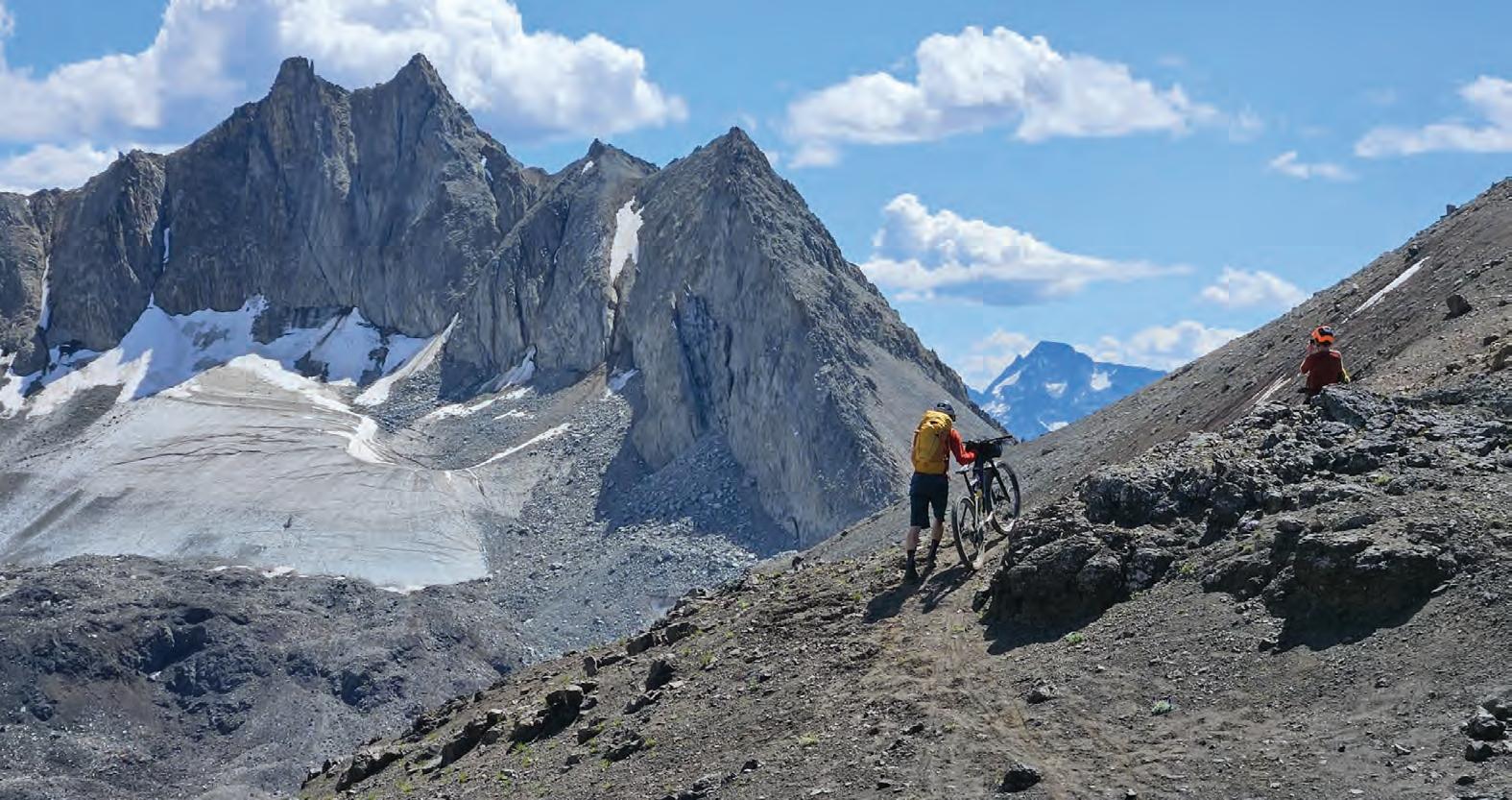
Rediscovering the Chilcotins: Part 2
ONCE IN A WHILE , a friend will invite you on a trip with a few unknowns. The starting point and end point are more or less clear, but what you’ll encounter along the way is more of a question mark. If the instigator of this sort of trip knows what they’re doing, they’ll know to give all invitees the disclaimer.

BY VINCE SHULEY
“Not sure exactly how this will go, but it’ll be an adventure.”
Famous last words.
If you decide to join such a trip, it’s up to you how you want to navigate these unknowns. You can look at maps, search for trip reports, look at weather data, and undertake any other number of diligent preparations. Or you can turn up knowing it’s just going to be a long, hard day in the mountains and deal with each challenge as it arises.
My second day in the South Chilcotin Mountains was the latter. We set off from Bear Paw camp (the deepest backcountry camp operated by Tyax Adventures) and began the pedal and push up to Deer Pass. Rather than ride the traditional route down to Trigger Lake, my friends were keen to explore a route that traversed the slopes
of Mount Sheba. The peaks of Sheba stuck out like devil horns in the landscape, and depending on how the day went, we had a stretch goal of scrambling to its summit (2,666 metres).
We tried to stick to a marked mountaineering route on our paper map, but trying to push and carry our bikes over boulder fields meant we were thrown off course multiple times. Wrapping around the summit of Sheba almost three hours from our diversion at Deer Pass, we knew going anywhere near the summit was off the table. We still had a series of ridges to traverse— with their own unknowns—before dropping down to our final camp at Spruce Lake. The day was getting on.
The next couple of ridges were easier to access, but still needed a combination of hiking, pushing and carrying our bikes.
to descend a short but very steep and rocky couloir. One by one, we carefully climbed down the incredibly loose chute, one hand on the bike, one hand on the sketchy rocky outcropping. The shale rocks were sliding like tiny point-release avalanches, but we all made it without damage to our bikes, or ourselves. We shouldered the bikes once again to climb another steep and sandy slope to the ridge, where we hoped a remnant trail could lead us back towards camp.
The trail was overgrown with deadfall every few dozen metres. In the twilight, I almost lost the trail completely, having to holler to my friends up front to make sure I wasn’t wandering the wrong way across this hillside. After breaking out of the treeline once more, we spotted a mountain goat a few hundred metres away, staring us down like we had no business being in his habitat
Wary of my exhaustion, I took off down the trail behind my friends and remembered what mountain biking feels like.
Thankfully we were moving faster than the first part of the day and putting some of the more difficult terrain behind us.
We thought we were more on the descent part of the journey when we encountered a landslip that had washed away what was a mere trace of a hiking trail. We could not get down the hill without exposing ourselves to considerable fall danger, so we had to take the long way around. We managed to make our way down to a lower ridge, where we had
(something we all agreed on at that moment).
At this point, I had very little gas left in the tank. I’d eaten all the food I had allocated for the day and still had water, but nutrients didn’t seem to be helping anymore. We had to push up another couple of ridges before we could finally see our final descent, a bike trail called Open Heart. Wary of my exhaustion, I took off down the trail behind my friends and remembered what mountain biking feels like. Despite a long day of exploration and
misadventure around Mount Sheba, our day finished on a high note before rolling late into camp at Spruce Lake. The stats for the day weren’t mind-blowing (27 kilometres, 1,418m elevation gain), but the arduous travel in non-mountain-bike terrain took its toll. The day of unknown adventure was complete, and we were all in agreement that the route we took was not a good fit for mountain bikes.
Our third and final day promised a much more well-beaten path, but by no means a small day. From camp at Spruce Lake, we pedalled and pushed our way back up Windy Pass and over to the slopes of El Dorado before branching out over to Camel Pass. The last big push of the day took us up a trail known as Ridge-a-Rama, where despite the hordes of horseflies, we relished one of the finest panoramic views of the Chilcotins, the devil horns of Mount Sheba now far on the horizon.
The descent from the ridge down to the start of the North Cinnabar Trail was one of the most enjoyable of the weekend, and we filled our water bottles in the creek before the final climb and dusty descent down to Tyaughton Lake.
Our group congregated at the dock in front of Tyax Lodge, where we ran into a group of Whistler friends who had their own stories of Chilcotin adventure and misadventure. Three days of travel by bike. Two nights self-supported backcountry camping. Total distance: 100 kilometres. Total elevation gain: 4,800 metres. Total regrets: zero.
Vince Shuley was well overdue for some real adventure biking. For questions, comments or suggestions for The Outsider, email vince. shuley@gmail.com or Instagram @whis_vince. n
PHOTO BY BEN HAGGARD
Want climate action? You’re part of a silenced majority
MOST PEOPLE WORLDWIDE want action on climate change. A significant majority would even be willing to give up some of their income to help. You wouldn’t learn that from most mainstream media or politicians.
A 2024 survey of 130,000 people in 125 countries, published in Nature Climate Change, found 89 per cent want “intensified political action” on climate and 74 per cent would be willing to contribute a small percentage of their income to the cause. (The
effective climate policies relies on popular support, and even in non-democratic societies, leaders remain attentive to prevailing political demands.”

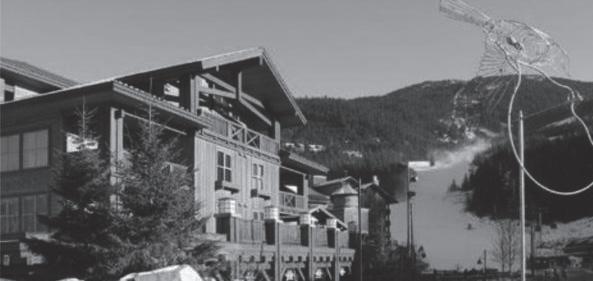
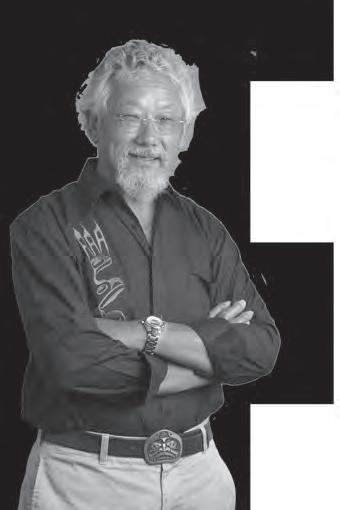
Survey co-author Stefania Innocenti, from the University of Oxford’s Smith School of Enterprise and the Environment, said this disconnect leads politicians to water down policy proposals. “Policymakers will try to play it safe if they feel they have no public mandate.”


BY DAVID SUZUKI
countries surveyed accounted for 96 per cent of global greenhouse gas emissions, 96 per cent of gross domestic product and 92 per cent
Yet even many politicians who profess to understand and take the climate crisis seriously continue to promote fossil fuel development,
Often that’s because they’re beholden to the fossil fuel industry—thanks to lobbying and lucrative campaign donations, promises of cushy board positions on leaving politics and other support—or because they have interests and investments in the industry. But sometimes it’s because they believe the lie that there’s little or no public support. The survey’s authors note that this “perception gap” makes it difficult to implement necessary climate policies.
Consider that, in the last federal election, in response to a misleading industry and opposition campaign, the Liberals decided to get rid of an effective, and popular, policy for reducing greenhouse gas emissions, the
The study’s lead author, Ximeng Fang, of the Saïd Business School at Oxford, said, “Net zero is not just feasible but also economically sensible.”
Beyond their economic benefits, robust climate policies are crucial to human health and well-being. The world has already wasted too much time debating whether or not they’re needed.
The consequences of burning fossil fuels and degrading and destroying carbon sinks such as forests and wetlands are clear: an overheating world is causing less predictable weather, increasing droughts and floods, rising sea levels, ballooning health-care costs, more conflict and growing human migration.
Now scientific research has concluded that the Atlantic meridional overturning circulation, a critical component of the global climate system, will likely collapse if we don’t quickly get emissions under control. Recent analysis shows we’re likely to pass the tipping point within a few decades, with the collapse occurring 50 to 100 years after that.
“It would shift the tropical rainfall belt on which many millions of people rely to grow their food, plunge western Europe into extreme cold winters and summer droughts, and add 50cm to already rising sea levels,” the Guardian reports.
There’s no reason to let this happen. We understand the problems and their solutions.
People really do have the power. We
just need to come together and exercise it.
carbon levy.
With much of mainstream media owned or controlled by people allied with, or at least sympathetic to, the oil, gas and coal industries, the real story gets ignored. Many people who support robust climate action simply don’t know they’re part of a large majority.
Even delegates to the United Nations Environment Assembly—191 from 53 countries, including policy negotiators— massively underestimated public support for climate policy, the Guardian reports. They estimated that, on average, 37 per cent of people would be willing to pay one per cent of their income to combat climate change. The true figure was 69 per cent, with an additional five per cent in favour of contributing a smaller amount.
As the survey study points out, “In democracies, the implementation of
Most will create numerous economic benefits, reduce pollution and related health impacts and, if done properly, decrease the wealth gap and create greater global equity.
All that’s holding us back are the fossil fuel industry and its supporters, including complicit media, politicians and those who view systemic change as a threat to their obscene wealth. It’s plain to see how they conspire to convince the public that support for policies isn’t there. But it is.
People really do have the power. We just need to come together and exercise it.
David Suzuki is a scientist, broadcaster, author and co-founder of the David Suzuki Foundation. Written with David Suzuki Foundation Senior Writer and Editor Ian Hanington.
Learn more at davidsuzuki.org. n

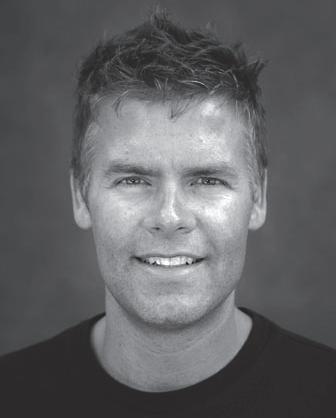


Meetwithmevia videoconference, telephone,and inperson. SHOLTOSHAW
Fare Change
Effective October1,2025

604.932.3211 s.shaw@raceandco.com
Fare products sold in the Whistler Transit System willhave updated prices and policychanges:
DayPASSwill replace Transfers and willcapfares daily after a second trip Thismeansyou’ll neverpaymore thanthevalueof a DayPASSin a single transitday.
Products purchased before October 1 willcontinue tobeaccepteduntil used up.
Forfullpriceandnew product details, visit bctransit.com/Whistler.
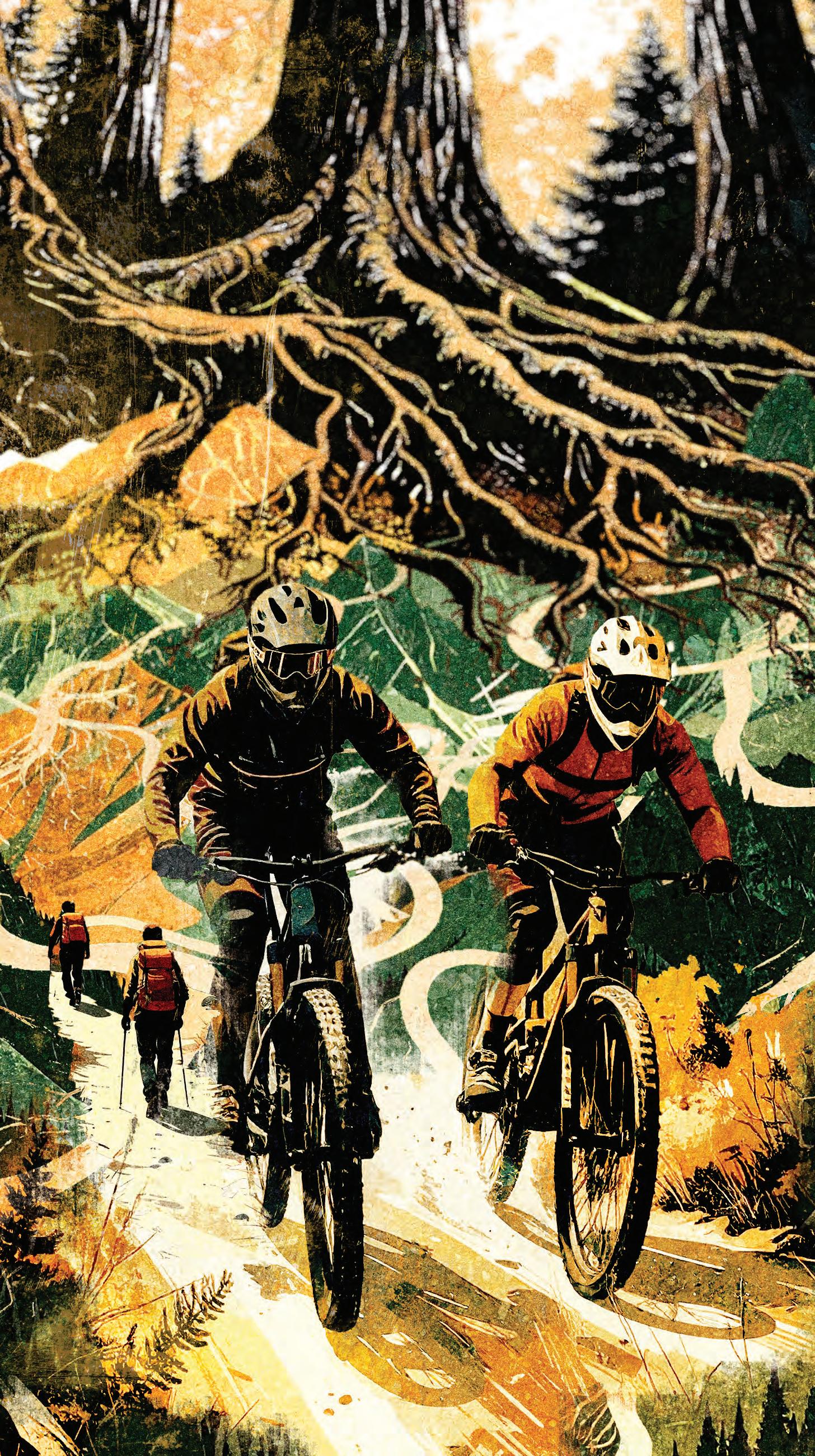
By Luke Faulks, Local Journalism Initiative reporter
IFllatlandbikes on pirate trails
n 2000, Hugh Naylor was standing in a courtroom facing a trespassing charge. His crime? Clearing and maintaining a trail along the Lillooet riverbank near his farm, a path that had been walked for decades. The neighbour, an American landowner, insisted it was hers. And while the judge was sympathetic to Naylor, he ultimately agreed with the landowner.
“It was a charge of $115,” Hugh recalls. “And the judge said, ‘I better find you guilty,’ which is fair. I was guilty as hell. But he said he’d lower it to $1.”
The story made its way through the valley and lit a fuse. Within weeks, Hugh remembers, Squamish-Lillooet Regional District chair Susie Gimse had convened a meeting of residents and trail users.
“So that was basically the first PVTA meeting,” Jan Naylor—Hugh’s wife—remembers.
Out of that conflict, the Pemberton Valley Trails Association (PVTA) was born—a group that would come to steward community access to trails across the valley.
Planner Erik Morden sees stories like this across British Columbia. His master’s research revolved around the factors that drive a community’s transition from a series of unsanctioned trails to a professional network.
“Your community group of volunteers doesn’t get together if it doesn’t have a need,” he explains in an interview with Pique. “In trails, a lot of the time it was around advocacy, because the trails were either threatened or access was being restricted.”
In other words, the Naylors’ $1 fine was not just a local drama. It was part of a provincewide pattern of grassroots organizing that continues to shape B.C.’s outdoor culture.
‘RAW LAND’
To understand how much was at stake in that court case, you have to go back three decades, to when Hugh and Jan first came to the valley.
What Pemberton’s story reveals about the evolution of trail culture
“We just had to get the hell out of the city,” Jan says, laughing, when asked why they left Vancouver in 1967. Hugh put it another way:
“You know the expression, back-tothe-landers? We were back-to-the-land types,” he says. “Yeah, we’re hippies.” When they arrived, Pemberton’s population numbered about 250 people. The Naylors bought

“One of the great things about living in a community in Pemberton is you make it happen.”
- Lizzie Stone


an acreage on Urdal Road, an area they remember as just being “all raw land.” The couple threw themselves into farming, raising children—their first, out of a tent for a few months as their house was being built—and exploring the Valley.
“We were hikers, skiers. We did a lot of backcountry skiing in the Garibaldi area and everything. And did the Kootenays. We were all over the place,” Hugh recalls.
Closer to home, they found joy in biking and walking along the valley floor.
“We used to be able to go up and down the dike all the way up to the highway bridge, and go across there and then go all the way up to Mount Currie. It was just old forest service roads up here,” Jan says.
Their style was practical, not extreme. They rode on the flats, rather than exploring the hills that frame the Village and Meadows. But even then, they noticed a difference between their quiet rides and the ambitions of younger adventurers.
“This was a few middle-aged people like us on road bikes, or just ordinary bikes, touring around the flat land. But, lurking in the background, were guys who wanted to rip around on the hills. That’s what they’re interested in,” Hugh says.
The question of who Pemberton’s trails are built for is part of what has defined the Valley’s trail-network growth.
WHOSE TRAILS?
For the first three decades the Naylors were in town, trails had mostly felt like community commons. Any early conflicts were between neighbours; who could walk where, who could ride along the river.
But as Morden pointed out, there’s another issue to consider: About 95 per cent of land in B.C. is unceded Indigenous territory and every trail disrupts that land; therefore, the consent of local Indigenous groups is essential not just for legal clarity, but for the long-term legitimacy of the trail.
His research notes that kind of relationship-building can be difficult for volunteer-run groups to manage on their own. He quotes John Hawkings, from the BC Ministry of Environment and Parks, as saying:
“The complexity on the land base now compared to even 10 or 20 years ago is very high. The Province’s commitment to reconciliation means that trail proposals have to be consistent with the rights, title, and interest of Indigenous communities. Navigating those complexities, having the capacity for the clubs, the organizations and government, for that matter, to build the relationships with Indigenous communities and to ensure that our trail networks, our
proposals, are actually consistent with those interests is a lot of work and a lot of time and commitment.”
Working productively with Indigenous groups is only one part of the broader shift underway. Trail networks that once served a narrow user base—hikers, mountain bikers— now need to accommodate much more.
“After a while, the bikers said, ‘Well, just a minute here, there’s a whole bunch of other people who’ve got other concerns other than dikes and bad neighbours and everything,’” Hugh says about the early days of the PVTA.
In addition to managing the differing needs of flat-land and mountain bikers, Pemberton’s strong horse-riding identity had to be addressed.
“Essentially every trail was a horse trail, originally,” says Jacqueline Chapman, president of the Pemberton Valley Horse Association (PVHA). She told Pique it’s an ongoing challenge to “increase our safety communication and public awareness with how to safely share trails with horses.”
Chapman’s perspective aligns with Morden’s call for inclusive trail governance: “making sure horses have a voice, motorized users have a voice, a platform to discuss.”
That expansion of voices is what the Pemberton Valley Trails Working Group (PVTWG) was formed to support. Launched in 2022, the PVTWG is a consensus-based advisory
table bringing together trail stakeholders from across the region—including the PVTA, PORCA, PVHA, the SLRD, the Lil’wat Nation’s Title and Rights Department, BC Parks and recreation planners.
Kristian Manietta, race director for the Pemby Pounder, sees this inclusivity as a strength.
“Obviously, the community is growing, and with that, we see way more mountain bikers, way more trail runners, way more trail users in general, which is great if people are getting out and using them,” he says.
THE PROS & CONS OF LEGITIMACY
For the Naylors, the neighbour dispute and resulting fine made one thing clear: informal trail use could no longer be taken for granted. The PVTA emerged directly from that tension, and from the need to clarify what land was private, what was public and what belonged to everyone.
Across B.C., it’s a common pattern. Sanctioning of trails often follows widespread informal use. In multiple case studies— Squamish, Vancouver’s North Shore,
PHOTO COURTESY OF THE PEMBERTON VALLEY TRAILS ASSOCIATION
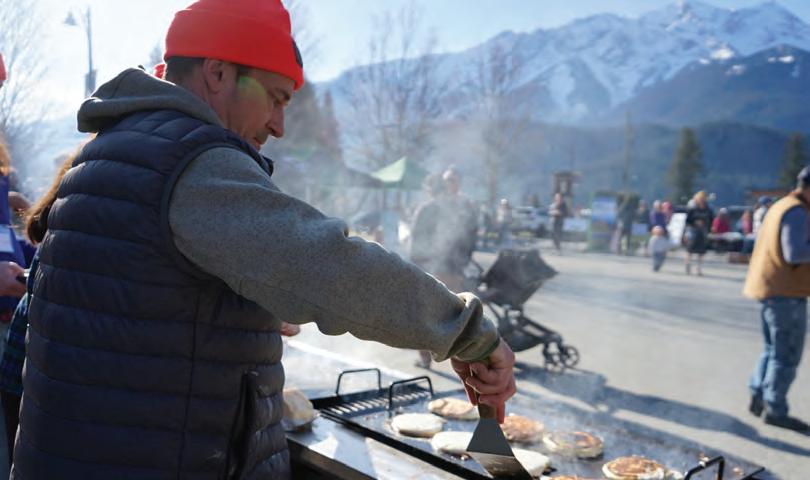
“Your community group of volunteers doesn’t get together if it doesn’t have a need.” - Erik Morden
Nelson—community use preceded formal approval by decades.
Take Vancouver’s North Shore, the cradle of freeride mountain biking. Trails in the area were predominantly built during the 1980s and ’90s, often without oversight or formal permission.
It wasn’t until 1997 that local advocates formed the North Shore Mountain Bike Association, prompted in part by trail sabotage and rising pressure to formalize the popular sport. Like with Pemberton, that marked the first step toward partnership with municipalities like the City and District of North Vancouver.
That process of legitimization brings challenges: overlapping tenures, unresolved land claims and environmental reviews.
In many communities, land is managed by a mix of actors—provincial ministries, forest licensees, private landowners, municipalities and Indigenous governments— with few shared means for coordination. Trail associations often find themselves navigating this fragmented terrain with little formal training or funding.
Even determining who holds jurisdiction over a particular trail corridor can be difficult. In some areas, trails cross multiple tenure types or lie within disputed territories. Without formal agreements or sanctioned planning processes, this can stall trail maintenance, complicate liability coverage and impede long-term investment.
As a result, well-used community trails can exist in legal limbo for years, even decades—loved locally, but vulnerable on paper to trespassing charges like the one Hugh Naylor faced.
Meanwhile, legitimizing the trail process unlocks funding and clarity.
“No one’s going to give you money if you don’t have a plan,” says Mark Barsevskis, an outdoor recreation planner with Whistlerbased McElhanney. “But once you have that trail master plan, and everyone’s on the same page, then you can actually start allocating proper volunteer hours.”
He notes unsanctioned trails—even wellloved ones—put organizations in a grey zone. Liability, environmental impact, and conflict with other users all become harder to manage.
“There’s a big difference between a rogue line and a maintained community asset,” Barsevskis says.


trails, but the professional planning side just kind of gives you a corridor—an area to build the trails, so then you can still let those hippie, guru, old-school trail builders [have] that area and that corridor to build in.”
In other words, the culture isn’t disappearing, it’s adapting. Volunteerism still matters, but it now lives alongside trail counters, geodata, insurance requirements and multi-agency planning tables.
The professionalization of the trails process raises another question; how to safely and sustainably maintain a trail once it’s been built. Morden says there’s not always an easy answer.
“Maintaining infrastructure isn’t sexy,” he says. “That’s where it becomes challenging. We need to find ways to maintain our trail systems.”
Barsevskis says the tide is slowly moving in the right direction on that front.

Trail-planning in the Valley also needs to accommodate Pemberton’s strong horse culture

‘STICK UP YOUR HAND AND DO IT’
The Naylors remember those early days of the PVTA as being hands-on. Trails needed clearing, bridges needed repair and maps needed drawing. Pancake breakfasts helped raise money. And neighbours pitched in.
That grassroots spirit remains strong.
Lizzie Stone, a PVTA director-at-large, moved to the community a few years back and quickly found herself pitching in.
“One of the great things about living in a community like Pemberton is you make it happen,” she says. “So if there’s a gap, you don’t wait for someone else. You’ve got to stick up your hand and do it.”
The research bears it out: As trail systems mature, volunteers are doing more than digging—they’re navigating bureaucracy.
Still, Barsevskis believes there’s room for the spirit that built the trails in the first place.
“You can still have volunteer days and keep the rogue kind of feel of it,” he says. “But I think people are starting to see the importance of … legitimacy.”
“You can still build those amazing, fun

“I think the grant funding is getting better for maintenance,” he explains. “Provincial governments, federal governments are starting to realize that. But, yeah, trail maintenance can be a harder sell. Usually you’re going to get more grant funding if you prove that this community needs a trail, and it can boost tourism.”
LOOKING BACK
Today, Pemberton is one of the fastest-growing communities in the province. Between the 2016 and 2021 censuses, the population jumped 32.4 per cent—from 2,574 to 3,407. With that growth has come pressure: more riders, more runners, more horses, more trail users of every kind.
In the 20 years after that $1 fine, the Valley’s community groups say the trail network has more or less grown to meet the population. Per TrailForks, the valley now boasts 734 kilometres of mapped trails across multiple disciplines—from hiking and horseback riding to e-biking and backcountry skiing.
It’s part of why Morden calls trailplanning “a community art project”—one shaped through conflict and collaboration. The Naylors’ story shows how that art unfolds: from flatland bikers to mountain cyclists, from neighbour disputes to Indigenous consultation, from rogue paths to sanctioned, regionally integrated networks.
The Naylors say they couldn’t have predicted the scale of the Valley trail network’s growth. But for all the planning tables and kilometers added, they say the heart of it hasn’t changed—it still comes down to neighbours showing up to pitch in.
“Some days, all it cost us was pizza and beer for those volunteers,” recalls Jan. “So, who wouldn’t want to come along?” n

An

PHOTO COURTESY OF THE PEMBERTON VALLEY TRAILS ASSOCIATION
PHOTO BY ANI DIME
PHOTO COURTESY OF THE SLRD
Contact



Joinustocelebrate!
Ifyourfamilyhasbeenpartofourjourneyover theyears,comeenjoyanafternoontogether. Honouringfourdecadesofcare,learning,and community,onelittlefootstepatatime. Sunday,October5th 3pmto5pm Allarewelcome!


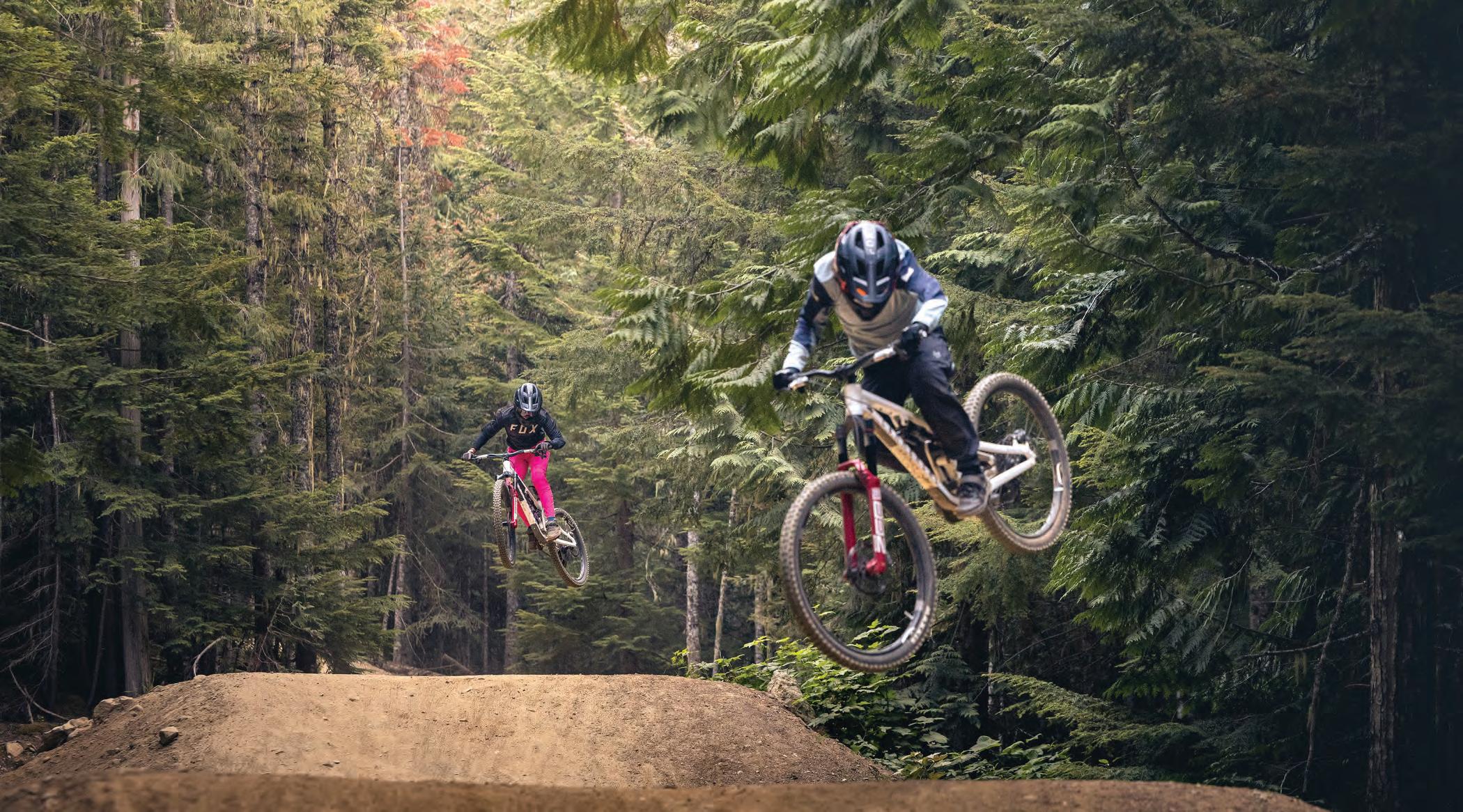
Whistler Mountain Bike Park celebrates 20 years of Women’s Night
SEPT.
13 WILL FEATURE A SPECIAL DAY-LONG EVENT
BY DAVID SONG
IF YOU VISITED the Whistler Mountain Bike Park in 2005, you would have encountered a predominantly male client base. That’s why Whistler Blackcomb (WB) launched a Women’s Night that year: to help ladies feel comfortable riding and developing their abilities in a safe environment.
This year, the program accommodated 605 registrants—a far cry from the 30-ish drop-ins during those early days. It has operated two nights a week for some time and become a curriculum suitable for all experience levels. Some who participate have never ridden before, while others are capable of lapping Dirt Merchant, Crabapple Hits and the Bike Park’s most difficult trails.
It’s only appropriate that WB mark this two-decade anniversary with a treat for its female riders: an all-day affair on Sept. 13 involving on-bike challenges, various contests like best costume, prizes and of course, quality coaching.
“It’s a huge milestone for us, seeing where
we’ve evolved and the growth of [Women’s Night],” said Sarah Harrison, assistant manager of WB’s Bike School. “We feel that putting on this event is a way to bring past and present participants together and really embrace the community that we’ve formed throughout the years. We even have women reaching out that are coming back
estimated 25 coaches or more to lead various sessions. Those who feel daring—and who have appropriate prior experience—can tackle new challenges like the A-Line rock drop, the Cat’s Meow or their first jump. Lunch is provided, and after things wrap up at 4 p.m., WB will put on an après at a location to be determined.
“They’ve really found a space where they can excel and feel confident. It’s just so inspiring to see...”
- SARAH HARRISON
from Australia. There’s been some lifelong friendships made throughout this program, and we hope to celebrate all of our successes.
“When I started biking, I used to go with my girlfriends—who I met in Ladies Night— and we would feel like we were a minority. Now you look around and the trails are pretty even out there. You see friends you have made throughout the time riding, or you make new friends on the chair who want to drop in with you.”
The festivities begin at 9 a.m., with an
‘A SPACE WHERE THEY CAN EXCEL’
Over the last two decades, Sea to Sky folk have enjoyed a front-row seat to the evolution of female mountain biking. Alma Wiggberg rose to victory at the first ladies’ Red Bull Joyride in 2024, while locals such as Georgia Astle, Miranda Miller and Andréane Lanthier Nadeau built a legacy across multiple disciplines. The future also looks bright, spearheaded by emerging World Cup stars like Elly Hoskin as well as a bevy of youngsters: Ruby Wells, Cami
Bragg, Arleigh Kemp and more.
Women are also establishing themselves firmly in the realm of coaching. Harrison’s team is nearly 50/50 in terms of gender ratio, with several ladies facilitating one weekly Women’s Night and participating in the other. Coach-specific sessions on Fridays often turn out to be more popular than other programs.
When these ladies aren’t mentoring others, they can be found racing at Crankworx, Phat Wednesdays and local enduro competitions.
“They’ve really found a space where they can excel and feel confident. It’s just so inspiring to see and I’m so proud to be a part of that,” Harrison remarked. “We have females that are coaching women and men, which is incredible, and it really all stems from the evening programs. That’s where they started. We really feel like there’s a platform for them to excel, to have a community and just have fun out there.”
Approximately 200 people have signed up for the Women’s Night anniversary event as of this writing, and registration will stay open until the day it happens. Tickets cost $20, which Harrison says is a reference to 20 fruitful years of progressing and making connections in the Bike Park.
Visit whistlerblackcomb.com/ explore-the-resort/activities-and-events/ whistler-mountain-bike-park/plan-your-ride/ events/20th-Anniversary-Womens-Nights. aspx for details and to register. n
BLAZING TRAILS Two women hitting jumps at the Whistler Mountain Bike Park.
PHOTO BY ROBIN O’NEILL

Jackson Goldstone rockets to first downhill World Championship title
GRACEY HEMSTREET FOURTH IN LADIES’ RACE AS VALENTINA HÖLL CLINCHES FOURTH STRAIGHT WIN
BY DAVID SONG
JACKSON GOLDSTONE is officially golden on his sport’s biggest stage.
The Squamish downhill ace ascended to UCI World Championships victory during his very first elite appearance at the Sept. 7 event, blasting to the finish line in Champéry, Switzerland (2:54.153).
German silver medallist Henri Kiefer (2:56.099) and bronze medallist Ronan Dunne of Ireland (2:56.146) were both almost two seconds slower than the triumphant Canuck, who also prevailed in qualification.
“That was probably some of my best work on a mountain bike. I struggled the first two days, then as soon as the [qualifying] run came I felt like it was on and I left everything out on track there,” said Goldstone in a press release. “Coming across that grass section, I felt like I was on a wild horse and just trying to hold on.”
The 21-year-old also dedicated his breakthrough to Stevie Smith, who passed away nearly a decade ago in an enduro motorcycle accident. Whistler’s 1199 downhill course is named in Smith’s honour.
It was business as usual on the ladies’ side of the bracket with Valentina Höll donning the rainbow jersey for a fourth straight year (3:27.506). Myriam Nicole filled the runnerup spot (3:27.803) and her French compatriot Marine Cabirou was third (3:28.227), with Sunshine Coaster Gracey Hemstreet in fourth (3:29.725).
Heading into Sunday’s race, Höll had not topped a podium since last year’s World Championships in Pal Arinsal, Andorra.
“World Championships are always something special and it brings out the best in you,” Höll told reporters after ending her winless streak at 372 days. “Definitely this year hasn’t been easy, I just couldn’t find my fire. Honestly, I didn’t expect it for this race, I didn’t feel the season was mine. I just tried to give my best, not think about any outcome.



Ourosteopathyandmovementcoachingblendshands-ontreatment,strength,mobility, coordinationandbiomechanicaloptimizationtorestorefunction,promotelong-term healthandhelpyoufeelyourbest—onandoffthemountain Cons ta ntmuscleti gh tness? annoying pa inth at justwon’ tgoa way? avoidingan ym ovementsoractivities ? Stil lo vercomin go ldinjuries ?
“Today I just relied on my confidence and the reason why I started riding—to have fun—and this is something that I wanted to get back.”
‘JOB DONE’
Riders enjoyed ideal conditions in Champéry, and Kiefer took advantage as the first man to break the three-minute barrier. Three ex-World Champions, Aaron Gwin, Charlie Hatton and Danny Hart, failed to follow suit. Dunne came close, and Andreas Kolb crashed amidst a promising run.
Reigning World Champ Loris Vergier found himself unable to match Goldstone’s blistering velocity (the Squamolian led everywhere apart from split No. 2) and ended up fifth. That left only Loïc Bruni in the starting gate, but the five-time Champion met the same fate as Kolb by going down.
Goldstone celebrated on Instagram with a rainbow emoji and two words: “Job done.”
The Squamolian couldn’t partake in the 2023 and 2024 Worlds contests but has now made his presence felt in compelling fashion.
Fellow Sea to Sky athletes Dane Jewett and Ryan Griffith, plus Red Bull Joyride winner Emil Johansson, were among the many who took to social media to congratulate Goldstone on his watershed achievement.
Shortly before her male peers dropped in, Nicole put her forgettable qualifying round in the rearview to establish a lead over the women’s field. Neither OG Canadian Open DH queen Mille Johnset nor three-time European Champ Monika Hrastnik nor Cabirou could do better, while a punishing bottom half of the course knocked Tahnee Seagrave into seventh: a downgrade from her third-place Worlds result in 2024.
Hemstreet was quick, but not quick enough to challenge for medals. Höll would not be denied: taking an early lead over Nicole and hanging on at the finish with 0.667 seconds to spare.
Visit valais2025.ch/results for more UCI World Championships results. n
Wethinkdifferently andcreatively Welookat thewholepicturebut also focusonthedetails Wedigdeepandfindtheroot cause 1:1personalizedsessions—nocookiecutterprogramming
Most insuranceaccepted
Whistler Women’sHockey



STAY GOLD Jackson Goldstone celebrates his third World Cup downhill win on June 1 in Loudenvielle, France.
PHOTO COURTESY OF UCI

Thai chefs Bo Songvisava and Dylan Jones to grace Mekong Oct. 18
THE HUSBAND-AND-WIFE DUO OPERATE THE BO.LAN RESTAURANT IN BANGKOK
BY DAVID SONG
LOCAL FANS OF Southeast Asian cuisine rejoice: Mekong is planning to host an exclusive one-night collaboration with Duangporn “Bo” Songivsava and Dylan Jones in Creekside.
In early 2009, Songivsava and Jones founded Bo.lan together on a shoestring budget in Bangkok, Thailand. Their restaurant has been previously starred in the Michelin Guide, featured on Netflix in Chef’s Table and honoured for its commitment to authentic Thai food and sustainable business practices.
Songivsava was born to a pair of cooks and viewed food as a way to express love to others. She achieved a master’s degree in Gastronomy in Adelaide before returning home to Bangkok and launching her culinary career. The Thai national worked a stint at London’s now-shuttered Nahm restaurant, where she met Jones.
Whenever she’s not busy at Bo.lan, Songivsava runs a weekly TV show dubbed Eat Am Are and teaches at a number of Thai universities. In 2013 she earned the maiden Asia’s Best Female Chef award, as part of Asia’s 50 Best Restaurants.
Jones, meanwhile, is an Aussie who figured getting a chef’s job would be simple
because everybody needs to eat. He trained in Canberra and Melbourne, developed his passion for Asian palates at Nahm, and relocated to Bangkok once he grew close to Songivsava on both a personal and professional level.
“Our philosophy is quite layered but at the base of it: we strive to make Thai food as we believe it ought to be served!” the couple explained in an email. “No compromising, but still being hospitable and accommodating.
had on the restaurant was overall far more positive—people coming for what we are offering rather than ticking a box.”
‘TECHNICAL AND PASSIONATE’
Songivsava and Jones put their money where their mouths are regarding environmentalism, as they believe the food industry is one of the largest contributors to climate change. Bo.lan
“Bo.lan is a restaurant that has truly helped to shape the modern Thai dining landscape in Bangkok...”
- ANGUS AN
We focus very much on supporting smallscale farmers, producers and Indigenous communities wherever possible. We have a goal of zero waste to landfill and showcasing Thai biodiversity.
“Recognition is great, but it’s fleeting and is not what drives us. We prefer to think that what we are doing can and is making a difference. In our opinion, the stars and lists don’t really represent the quality they used to. Netflix was a little different: it allowed people a glimpse into what we do and our philosophy. We feel like the impact that
staff utilize various eco-friendly mechanisms like a water filtration system, waste monitoring and upcycling, LED lights and uniforms made with local organic materials.
The Thai farmers partnered with Bo.lan work to regenerate soil and grow within the framework of seasonality and biodiversity, making for a stronger ecosystem as well as more nutritious food. Experience has shown a diverse food system is more resilient to ecological disruption, and local crops adapt far quicker than industrial foodstuffs.
Angus An, Mekong’s culinary director,
met Songivsava and Jones in the kitchens of Nahm and noticed their talent. He invited them up to Mekong—an offer that was enthusiastically accepted.
“This will be Bo and Dylan’s first visit to Whistler, and we look forward to having them share their unique cuisine with our community and cook alongside myself and Bonnie Khummuang, our executive chef,” An said in a press release. “Bo.lan is a restaurant that has truly helped to shape the modern Thai dining landscape in Bangkok and continues to do so. When we hosted Bo and Dylan last year at Maenam, tickets sold out in 24 hours. It will be a special evening.”
“Angus is one of the most technical and passionate cooks we’ve ever met!” remarked Songivsava and Jones. “Anything Angus cooks tastes good, so why wouldn’t we want to cook with him and his team? Doing an event like this with a friend is much more meaningful and exciting for us. We are very excited to go foraging for mushrooms and incorporate that into our menu [whilst appreciating] the beauty of the mountains.”
Authenticity can be a fickle benchmark— green curry alone has 20 to 30 family recipes that all claim to be authoritative—but the husband-and-wife duo research recipes from old texts and decide for themselves what makes each dish great. Whistlerites looking to check out the fruits of their labour should mark their calendars for Oct. 18, with seatings at 5 p.m. and 8 p.m.
Visit 88mekong.com/events for tickets and more details. n
THAIS THAT BIND Left to right: chefs Duangporn
“Bo” Songivsava, Angus An and Dylan Jones. PHOTO COURTESY OF MAENAM


MEADOW PARK SPORTS CENTRE



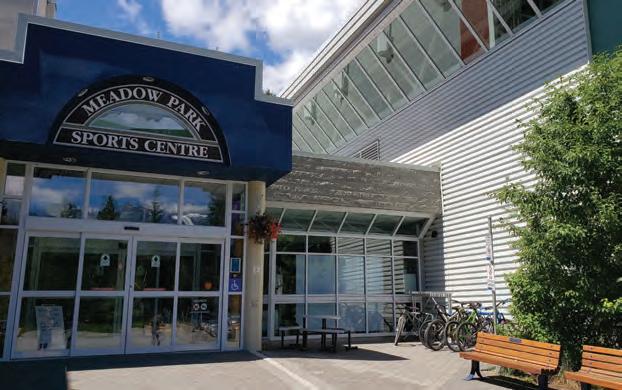


Whistler Writing Society hosts AGM and Open Mic Night Sept. 25
PART OF THE EVENT WILL HONOUR WRITERS FESTIVAL FOUNDER STELLA HARVEY
BY DAVID SONG
IT’S ALMOST TIME for the Whistler Writing Society (WWS) to put on its Annual General Meeting (AGM): a night to connect with members and other visitors over refreshments while discussing pertinent issues.
One of those topics might be the next Whistler Writers Festival (WWF) being scheduled for Oct. 30 to Nov. 2 in a departure from previous years. Festival director Rebecca Wood Barrett explained her team’s reasoning to Pique.
“That was a big decision. We needed to reach out to all of our venue partners and explain what was happening: the pressures of inflation and declining grant revenues were causing some financial challenges,” she said. “There are a number of literary festivals which happen in the fall, so we really have to be careful that we’re not on the same dates as the Vancouver Writers Festival and the Victoria Writers Festival because that would make it harder to get authors and audiences.
“And then there’s the Whistler calendar,
too. It’s like trying to find that sweet spot: we don’t want to do it on Thanksgiving, and we need to find a spot when the mountain is not open because that’s a quieter time in the resort. Our venues have stepped up, and really we’ve strengthened partnerships there.”
The AGM will take place from 6 to 6:30 p.m. at the Whistler Public Library, followed by a half hour of snacks and mingling. At 7 p.m., Open Mic Night (held in partnership with the Resort Municipality of Whistler)
with the former Citizen of the Year and play it during Open Mic Night.
In 2002, Harvey placed a note in the Whistler Question asking if people might be interested in a writer’s meeting. About 20 individuals and a guest author showed up to her house, and things snowballed from there.
Nowadays the WWS runs a full-fledged writer-in-residence program, writing retreats and multiple open mics throughout the year. The WWF attracts New York Times
“When you connect with somebody about your ideas, it validates the importance of what you’re trying to say...”
- REBECCA WOOD BARRETT
kicks off under the theme of “Celebrating Trailblazers and Tomorrow-Makers.”
It is only fitting then, that a portion of the evening will pay tribute to WWF founder Stella Harvey.
‘WHAT MAKES US HUMAN AND NOT A.I.’
Harvey won’t be able to attend, but Wood Barrett plans to film a five-minute interview
bestselling novelists, and the Authors in Schools program connects local youth with guest writers. None of it may have been possible without Harvey’s initiative.
“Stella is very passionate about supporting newcomers to Canada. She was an immigrant herself, and I think she’s always carried with her that sense of: ‘do I belong?’ So many of her works have to do with marginalized people who have come to a new country and are trying to figure out their path. She’s also a tomorrow-maker because she’s always trying new things … now working in graphic novels, she’s had to learn a whole new genre. That, to me, is remarkable.”
Open Mic Night participation is available to all Sea to Sky residents. Published and unpublished works of all genres are welcome, as is potentially mature content. Wood Barrett feels telling one’s own story and receiving feedback is a huge boost of encouragement for any author, no matter where they are in their careers.
“When you connect with somebody about your ideas, it validates the importance of what you’re trying to say—it’s what makes us human and not A.I.,” she remarked. “People are bringing the best parts of their work. They’re also bringing things that are maybe raw, with their emotions attached. We saw that at the last open mic: we had a couple of storytellers tearing up and the audience was tearing up.”
For more details, visit whistlerwritersfest. com/society-agm. n
“She really is the poster child and trailblazer for our organization,” said Wood Barrett. “She’s so adorable, for starters. She’s interested in everybody and likes to have conversations. If there was ever any kind of misunderstanding, organizing many people in many venues [for the Festival], she would say: ‘let’s get together for coffee and talk about it.’
TELL YOUR STORY Whistler Writers Fest founder Stella Harvey pictured at the 2022 Whistler Excellence Awards, where she was named Citizen of the Year.
PHOTO BY JOERN ROHDE / COURTESY OF THE WHISTLER CHAMBER
Laugh Out LIVE! unveils new sketch comedy class, expands improv offerings to Pemberton
TROUPE FOUNDERS IRA PETTLE AND REBECCA MASON DISCUSS WHAT’S TO COME IN FALL 2025
BY DAVID SONG
LAUGH OUT LIVE! has two major updates to speak of this fall: a brand-new sketch comedy course in Whistler and a Pemberton option for its returning improv class.
Sketch is featured in the group’s recurring Marquee Variety Show. If you’re unfamiliar with what that means, picture Saturday Night Live (SNL): brief, scripted segments typically under five minutes in length depicting various characters and a self-contained narrative.
The novel class is open to beginners and veteran actors alike, with Laugh Out LIVE! co-founder Rebecca Mason confident that all participants will gain something valuable from their experience.
“It’s about reading a script and dissecting the funny, really blowing up the characters so that they’re lovable and hilarious,” she explains. “We will be practicing essential performance techniques that will help students make bold comedic choices, as well as working with a cast in a scene: we’ll have the option to do monologues or sketches with more than one performer.
“Because it’s a project that the students will be seeing from beginning to end over five weeks, they’re going to be … cast into their characters and design a scene that they’re proud of. They can see it grow. They can learn the process of rehearsal. If anyone’s curious about acting, or if theatre is something they did in the past, this is the perfect opportunity [to reignite that interest].”
Mason’s business partner, Ira Pettle, describes the course as “the class/workshop version of community theatre.” Areas of focus will include overall stage delivery, comedic timing and character development.
“At the end of the day, it’s about play: tapping into your inner six-year-old, collaborating, being creative and connecting with people in a joyful atmosphere,” says Pettle. “There’s going to be sets, costumes and props. It is about the process.”
Sketch runs weekly at 7:15 p.m. from Sept. 17 to Oct. 15, at the Westin Resort and Spa, with an Oct. 17 showcase before a live audience to cap off the curriculum. Registrants who don’t wish to perform publicly are welcome to opt out of the latter.
‘A NATURAL PROGRESSION FOR US AND THE BRAND’
Since Day 1, Pembertonians have been making the trek south to be entertained at Laugh Out LIVE! events. A few, like Mark McIver and Julie Farr, are part of the group’s main cast at Marquee Variety Shows and Improv Battles. They’ll now be rewarded with an improv class close to home at the Pemberton and District Community Centre.

PHOTO BY JOERN ROHDE / COURTESY OF LAUGH OUT LIVE!
“We’ve got family in Pemberton and we’re very excited to be bringing classes to them,” Mason says. “We’re looking forward to this pilot class to teach us more about Pemberton’s needs and desires so that we can keep serving them. The students really shape the way that we shape each class.”
Pettle adds: “Over the course of the last four years, we’ve heard from multiple people asking us: ‘when are you coming to Pemberton?’ I think it was just a natural progression for us and the brand.”
Improv, unlike sketch, is entirely spontaneous. That may seem intimidating, but Laugh Out LIVE!’s leaders have seen firsthand it can be a life skill—not just a dramatic art. Practitioners learn to listen to their castmates, think on their feet, gain confidence and speak in public, all the while meeting others in their community.
“The No. 1 rule of improv is to say yes,” Mason remarks. “I think a lot of people, especially as we grow up as adults, harden over their inner child. The instinct to say yes and to build with others is a practice we [need] to keep nourishing.”
Laugh Out LIVE! has run improv classes for some time now, and Pettle believes they’ve grown as instructors. He and Mason’s goal is to adapt each session to fit the needs of their students: whether it’s training the next generation of actors or encouraging everyday folk to come out of their shells.
Pemberton improv will be held on Wednesdays from Sept. 17 to Oct. 15. Each class begins at 6:30 p.m., intended to give residents who work in Whistler time to get home while not occupying them too late. A public showcase (optional, like its sketch counterpart) is pencilled in for Oct. 17.
Find more details about Laugh Out LIVE! programming at laughoutlive.com/classes. n

13 SEPTEMBER

YouthMountainPhotography Workshop withBlakeJorgenson
Saturday,September13 10:00am -3:00pm
Inspiredby TheCoastMountains, discovertheartofcapturingbreathtaking alpinelandscapesinthisexclusiveyouthphotographyworkshopledby renownedoutdoorlifestylephotographerBlakeJorgenson.
*includessightseeingpasscourtesyof WhistlerBlackcomb

Registrationopen! Lear nmoreand registerat audainartmuseum.com
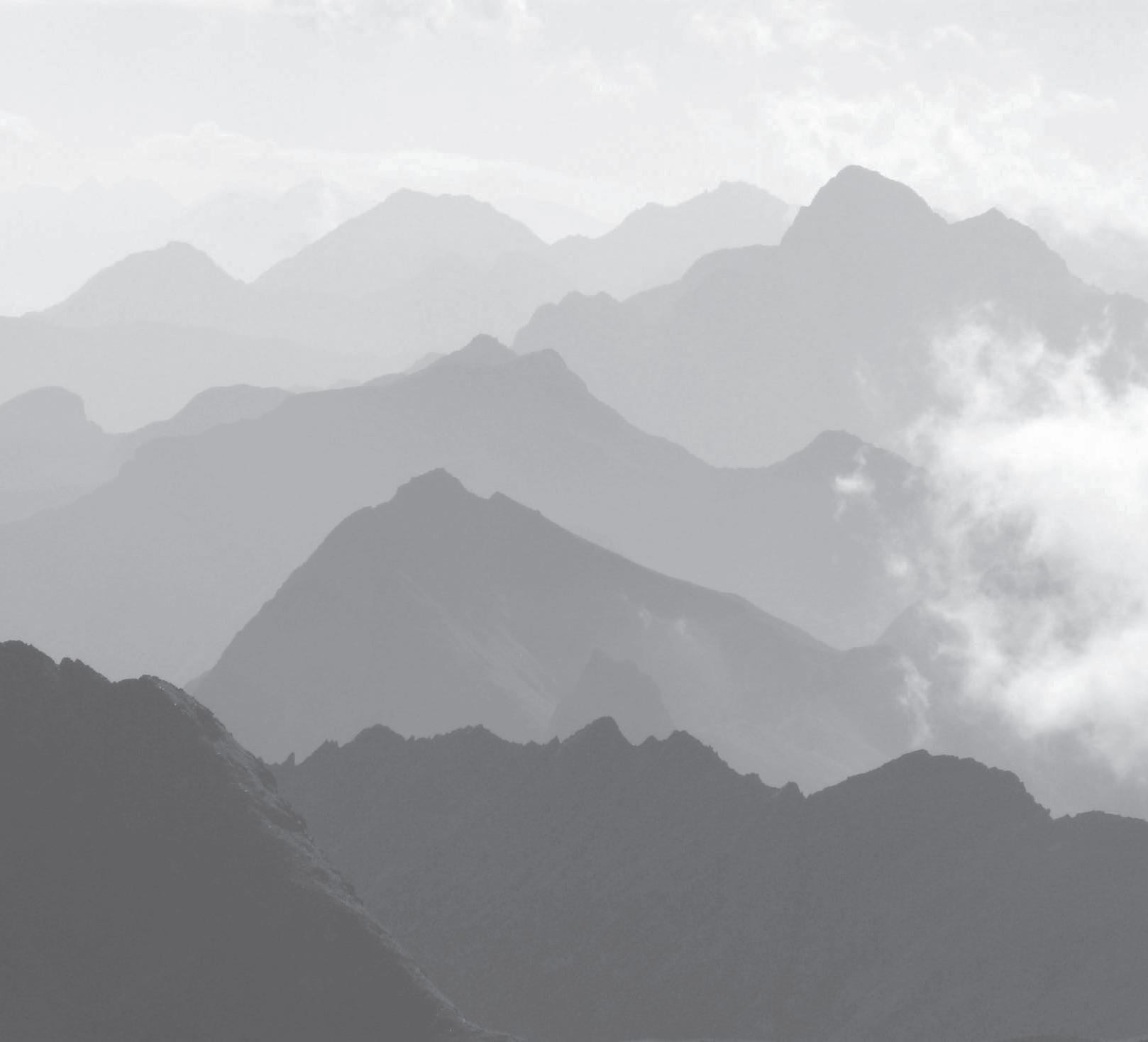
GO WEEK BIKE BY FALL
Whistler ,S ep t27- Oc t3




YES, AND Laugh Out LIVE! Presents: St. Patrick’s Secret Powder Stash in March 2024.

CALLFORFUNDINGAPPLICATIONS
Applicationsarenowbeingacceptedforour st October 1, 2025FallFundingDeadline.
toresidentsoftheSeatoSkyCorridor in theareasofhealth,humanservices, education,recreation,arts&culture andtheenvironment.Specialemphasis isplacedonchildren,youthandfamilyprograms. Formoreinformation, eligibilityrequirementsandtocompleteanapplication,pleasevisitour websiteatwhistlerblackcombfoundation.com,OrcontactMeiMadden, ExecutiveDirectoratmmadden@whistlerblackcombfoundation.com

Roland'sPubisopen forlunch Wednesdays& Thursdaysfrom11:30am! Joinourlunchclub! Get10stampsonyourlunchcardand your11thlunchisfree*(Restrictionsapply) Childrenarewelcomeeverydayuntil 10pm,sobringthekidsinforbrunchon theweekendsfrom11am-2pm.

ARTS SCENE
PIQUE’S GUIDE TO LOCAL EVENTS & NIGHTLIFE
Here’s a quick look at some events happening in Whistler this week and beyond. FIND MORE LOCAL EVENT LISTINGS (and submit your own for free!) at piquenewsmagazine.com/local-events

SATURDAY SESSIONS
TRAILBLAZERS TO TOMORROW MAKERS: RMOW’S 50TH ANNIVERSARY
This special exhibition, presented by Arts Whistler as part of the municipality’s 50th celebrations, features five established artists who have each mentored two emerging creators (ages 16 to 30) and collaborated on works that reflect Whistler’s legacy and future. The exhibition features pieces developed in the Village during launch weekend, alongside a tribute wall honouring creative icons from the past.
> Sept. 12, 6 to 8 p.m.
> Maury Young Arts Centre
WENDY THOMPSON MEMORIAL HUT - 25TH ANNIVERSARY
Celebrate 25 incredible years of the Wendy Thompson Memorial Hut at the Whistler Museum! This special milestone honours the hut’s rich history and the amazing community that has supported it along the way. Reconnect with friends, share stories, and make new memories over delicious pizza, appetizers, drinks, and a commemorative slideshow.
> Sept. 13, 5:30 to 9 p.m.
> Whistler Museum
SATURDAY SESSIONS WITH MAC
Join Whistler’s Mature Action Community (MAC) for a monthly series at the Whistler Public Library exploring a variety of topics, related to educational tips, health and well-being! On Sept. 13: A community response network coordinator and health-care consultant.
> Sept. 13, 10 a.m. to noon


> Whistler Public Library
RMOW’S 50TH
As part of the municipality’s 50th celebrations, the Whistler Public Library invites the community to connect through creative and collaborative events this fall. Includes a new oral history project with the Whistler Museum launching in late September, a highstakes Puzzle Competition in October, and a grown-up edition of Show & Tell in November. Stay tuned for confirmed dates and details.
> Sept. 14 to Nov. 30
> Whistler Public Library
BARS OF FURY
Featuring more than 1,500m of elevation drop, this high-alpine gravity race challenges riders to descend from Whistler’s iconic Peak Chair all the way to Dusty’s Bar & BBQ in the heart of Creekside.
> Sept. 14, 9 a.m. to 3 p.m.
> Whistler Mountain Bike Park
BLIND DRUNK: IN CONVERSATION WITH VERONICA WOODRUFF
Experience an evening of insight and reflection with local author Veronica Woodruff, as she shares excerpts from her powerful memoir Blind Drunk: A Sobering Look at Our Boozy Culture. The reading will be followed by an open, honest conversation about our community’s relationship with alcohol, along with a tasting of nonalcoholic wines.
.> Sept. 17, 7 p.m.
> Whistler Public Library
$3,898,000 tler



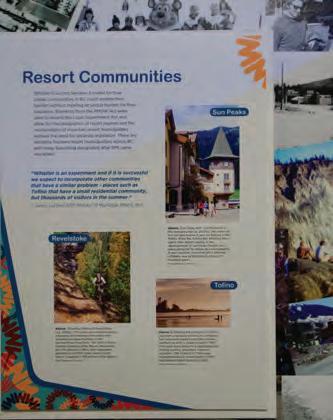


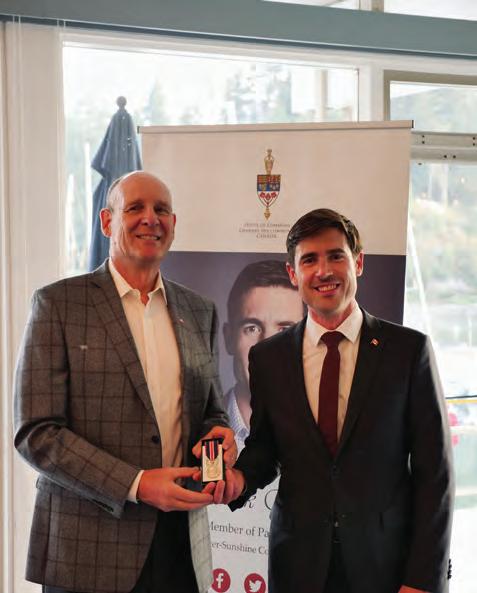




MUSEUM MUSINGS & ASTROLOGY
Whistler’s first election
BY ALLYN PRINGLE
ON SEPT. 6, 1975 , Whistler residents got to vote in their first municipal election and choose their first council representatives. The Resort Municipality of Whistler (RMOW) Act, which created Whistler as a resort municipality, was passed by the provincial government in June 1975 and a cabinet order in July set Sept. 6 as the day the Act came into effect. However, some sections of the Act, specifically those that allowed for the preparation for an election, came into effect earlier.
Campaigning began in August with posters, buttons, and campaign platforms published in the Squamish Times. Four people offered their name for the position of mayor: Paul Burrows, Roy Calder, Pat Carleton, and Roger Lampitt. Though each of the four had their own views on the challenges and unknowns facing the new municipality, all promised they would dedicate themselves and work hard if chosen. In his campaign, Carleton told voters, “I cannot promise miracles, I can only promise to do the best job possible.”
The three positions on council (at the time called aldermen) had seven prospects: Bob Bishop, Jack Bright, Frans Carpay, Julianna Heine, John Hetherington, Jan Systad, and Garry Watson. Whistler residents had three chances to cast their votes with two days of advance polling leading up to the election.

It was reported that about 80 per cent of eligible voters took part in the election and a total of 347 votes were cast. All voting took place at the Highland Lodge and the results were quickly reported in order to be ready for the swearing-in of council the following day. In what became a very close race for council seats, Pat Carleton, Bob Bishop, John Hetherington, and Garry Watson were voted into office.
Whistler’s first council was officially sworn in on Sunday, Sept. 7 by Judge Walker of the Squamish Provincial Court. Along with those who were elected, Jim Lorimer, the
Free Will Astrology
ARIES (March 21-April 19): I can’t speak the Quechua language, which is Indigenous to the Andes Mountains. But I have lifted one of their words to use for our purposes here: munay. It refers to an intensely practical and visionary love that includes far more than sweet feelings and affection. When we practice munay, we offer discerning respect and detailed appreciation to those we adore. We are generously eager to help our allies live their best lives. It takes discipline! And focus! And ingenuity! To be a rigorous and vigorous source of munay, we must cultivate it as a daily practice. In the coming weeks, Aries, I hope you will go a bit wild in your expression of this tender force of nature. Imagine yourself as a gentle whirlwind of love that spreads interesting beauty and bestows useful blessings. Be a relentless dispenser of catalytic gifts.
TAURUS (April 20-May 20): The medieval Persian polymath Avicenna believed the soul entered the fetus not with the first heartbeat, but with the first dream. I offer this idea for your poetic consideration, dear Taurus. Let’s imagine that the next beautiful thing you create will not arise from your forceful intention. Rather, it will emerge because you give yourself permission to fantasize, to wander freely in wonder, and to meander with curiosity on the frontiers. Your assignment is not to hustle, but to incubate; not to push forward, but to dwell expectantly in the mystery.
GEMINI (May 21-June 20): The bowerbird constructs elaborate ground-based shrines not as nests but as seduction lures. The enticer might gather blue bottle caps, yellow flowers, and shiny stones so as to create a scene that piques the attention of a potential mate. These objets d’art are not merely decorative. They are displays that demonstrate discernment, skill, and aesthetic intelligence. I authorize you to be like a bowerbird, Gemini. What collection of symbols, words, gestures, and curiosities will magnetize the people or opportunities you long to engage with? It’s not
Minister of Municipal Affairs, announced Al Raine as the provincial appointee to council, bringing the total number of council members to five. During the ceremony, Carleton was presented with a gavel from the SquamishLillooet Regional District (the area had previously been under the jurisdiction of the SLRD) along with a set of Lismore crystal glasses and an inscribed silver tray from Minister Lorimer.
Unfortunately for Paul and Jane Burrows, they missed the entire ceremony. The original plan was for the ceremony to take place in the Roundhouse at the top of Whistler Mountain
WEEK OF SEPTEMBER 12 BY ROB
about flashiness; it’s about alignment. What you draw into your sphere will reflect the vibes you emanate.
CANCER (June 21-July 22): The pearl doesn’t begin as treasure. In its earliest form, it’s an irritation: a grain of sand that’s really a wound inside the oyster. Over time, the creature coats it with layers of nacre, turning discomfort into luminescence. Let’s use that as a metaphor for you, Cancerian. In my view, your task right now is not to escape or shed what’s bugging you, but to expedite the coating process. What is that gritty thing? A memory, injustice, or unmet yearning? It’s crucial you don’t reject it and don’t let it fester. I think it’s best to turn it, layer by layer, into a luminous asset, even a treasure. Prediction: The pearl you form will long outlast the wound.
LEO (July 23-Aug. 22): Olive trees can thrive in rugged environments, including rocky and nutrient-poor soils. Their root systems are wide, deep, and resilient. They are welladapted to full sun, high temperatures, and low water availability. In comparing you to an olive tree, Leo, I’m not implying you will always have to be as hardy as they are. But in the coming weeks, you will be wise to be equally plucky and persevering. Here’s another fact about the olive tree you can and should emulate: Its fruit is valuable and in demand.
VIRGO (Aug. 23-Sept. 22): The Basenji is a dog breed that doesn’t bark. Instead, it produces an eerie, melodic yodel called a baroo. This oddity isn’t a flaw or drawback; it’s an interesting uniqueness. In the coming weeks, Virgo, I invite you to express your personal versions of the baroo—your idiosyncratic offerings and singular gifts. Playfully resist the pressure to be more conventional or “on brand.” Be faithful to what yearns to come out of you, which may be raw, radiant, and a little weird. Let your authenticity be exactly what it is: a beacon, not a liability.
LIBRA (Sept. 23-Oct. 22): Scientists discovered that some
BREZSNY
caterpillars, while dissolving inside their cocoons, retain memories of their caterpillar lives even after becoming butterflies. In my view, that’s equivalent to us humans remembering details of our previous incarnations: having an all-new body but being able to draw on what our past body learned. According to my analysis of the astrological omens, you will be able to draw on this amazing capacity in the coming weeks. The person you used to be will have key revelations and inspirations for the future you.
SCORPIO (Oct. 23-Nov. 21): According to Celtic mythology, Cerridwen is the goddess of inspiration. In her cauldron, she brews magical elixirs that bestow the powers of wisdom, creativity, and transformation. The humans most likely to earn her blessings are those who are patient and willing to be changed. Of all the signs in the zodiac, you Scorpios are now at the top of the eligibility list for gifts like these. And the next three weeks will be the most favourable time for you to ask for and receive such blessings. Here’s a clue that will help you get all you deserve: Believe in magic.
SAGITTARIUS (Nov. 22-Dec. 21): In ancient Chinese philosophy, ziran means naturalness, spontaneity. It might refer to the way a mountain is purely a mountain, and a wave is a wave without trying to be a wave. I think you Sagittarians are due for an extended engagement with this wild ease and elegant freedom. After weeks of inner labour, your soul wants to breathe in ziran. Your assignment is to let yourself be as natural and unconstrained as you dare—not correct or careful or “optimized.” So I advise you to head in the direction of what’s simple and real and good. Emphasize smoothness over effort. Choose your rhythm, not theirs. You aren’t required to prove your healing. You just have to live it.
CAPRICORN (Dec. 22-Jan. 19): “Serendipity” is an English term that refers to beautiful accidents, fortunate interruptions, unexpected opportunities, and surprisingly
and the lift company was going to provide free rides for attendees on the gondola and Red Chair. The location was switched on short notice to the base of Whistler Mountain (today’s Creekside area), after the Burrows had already started hiking up the mountain with their dog. They only learned of the change when they reached the top and, as their dog was not allowed to ride the chairlift, were unable to make it back down before the ceremony concluded.
The first council had a lot to get started on, including hiring the municipality’s first staff members, developing an Official Community Plan, beginning work on a municipal sewer system and treatment centre, drafting bylaws and having them approved by the province, finding more sustainable long-term waste solutions, and much more. They also had only 14 months before the next municipal election. While most municipal office terms at the time were two years, the Minister of Municipal Affairs dictated the length of Whistler’s first municipal council. Another election took place on Nov. 20, 1976, though the second council looked very similar to the first. All of the incumbents who chose to run again were re-elected and only one new face, that of Frans Carpay, joined Whistler’s council. If you’re interested in learning more about how Whistler became a resort municipality, be sure to visit the Whistler Museum’s latest exhibit, The RMOW Act, on display through Nov. 23. n
wonderful discoveries (the French equivalent is serendipiti; Italian: serendipiti; Japanese: serendipiti). The word didn’t exist until 1754, when author Horace Walpole coined it. Lovely outbreaks of good luck and uncanny blessings had been happening from time immemorial, of course, even though there wasn’t this precise word for them. Here’s a key point: They are more likely to occur if you believe they’re possible and make yourself alert for their arrival. That’s good advice for you right now.
AQUARIUS (Jan. 20-Feb. 18): The placenta is the only organ that the human body creates from scratch and then discards. Let’s pause for a moment to register how remarkable this is: to grow a temporary life-support system and then jettison it once its purpose is fulfilled. Inspired by this miracle, I speculate that you may soon undertake a metaphorical version of it. A situation or experience that has nurtured you is reaching the end of its mission. Though it has served you well, the wise move might be to outgrow it and move on to a new phase of your evolution. At the very least, it’s time to embark on a search for new forms of nourishment.
PISCES (Feb. 19-March 20): In Balinese gamelan music, there’s a technique called kotekan. Two instrumentalists play distinct musical parts that together create a seamless, intricately melodic and rhythmic texture. Let’s make this your metaphor to live by in the coming weeks, Pisces. In my astrological opinion, you are not meant to work solo. Your greatest success and most fun will come by generating harmony through collaborative improvisation and shared timing. A small warning: Someone else’s input may at first feel like interference, but it’s actually the missing part of the song. Let yourself blend, bounce, echo, and respond. Genius will be born in the spaces between.
Homework: Give yourself a pep talk about how smart you plan to become about love. Newsletter.FreeWillAstrology.com.
SWEAR WORDS Minister of Municipal Affairs Jim Lorimer speaking at the swearing-in of council on Sept. 7, 1975. LOVE MORRISON COLLECTION.
CALL OR PLACE YOUR CLASSIFIED WITH OUR ONLINE SERVICE FOR EITHER PRINT OR ONLINE...OR BOTH!

Whyworkwithus?
•Competitivewagesstartingat$30.94perhour
•Regularlyscheduledandcasualpositionsavailable
•Summers,holidaysandweekendsoff
• Consistentschedule:4hrs/day,10months/year,additionalhoursavailable
•Medical/dentalbenefitsandPensionProgramavailablefordrivers working20+hrs/week
• Trainingprovided,includingthecosttoupgradetoaClassIIdriver
licensewithairbrakeendorsement
How to apply?
• Visit makeafuture.ca toreviewthejobdetails/requirementsand tosubmityourapplication
Î Secure & scamless
Î Fully searchable
Î Targeted online community
Î Categorised listings
Î No reposting
Î Trusted by locals
Î Make your listing stand out with featured locations
•Email employment@sd48.bc.ca withanyquestionsorifyou wouldlikeassistancewithyourapplication


Î
*

Come buildandgrow withthebestteam.

Ourteamofpeopleiswhatsetsusapartfromotherbuilders.Aswe continuetogrowasthe leader inluxury projectsinWhistler,ourteamneedsto expandwithus.
We are currentlyhiring:
Labourers ($20-$30hourly)
CarpentersHelpers/Apprentices1st to4th year ($25-$35hourly)
ExperiencedCarpenters ($30-$45hourly)
Carpentry Foremen ($40-$50hourly)
Rates vary based onexperienceand qualifications.Red Sealis a bonus but not required Crane Operator experienceconsidered anasset.
EVR is committed tothe long-term retention and skillsdevelopment ofourteam We are passionateaboutinvestinginourteam’s future
WEOFFER:
• Top Wagesanda Positive WorkEnvironment
•FlexibleSchedule- WorkLife Balance (Wegetit,welove toskiandbike too.)
• Training& TuitionReimbursement(Needhelpgetting yourRedSeal?)
•Assistance withworkvisaand PermanentResidency (We canhelp!)
BENEFITS &PERKS:
• Annual Leisure& ToolBenefit – Use toward ski/bike pass,toolpurchase,etc. – you choose!
•ExtendedHealthandDentalBenefitsfor youand yourfamily
We promotefromwithinandarelookingtostrengthenouramazingteam.Opportunities for advancement intomanagementpositionsalways exist for the right candidates.Don’t missout onbeingabletobuildwiththeteamthatbuildsthemostsignificantprojectsinWhistler
Send your resumetoinfo@evrfinehomes.com We lookforwardtohearingfrom you!

Whatwe’reafter:
•Solidhands-onexperiencewrenchingoncarsandtrucks
•Comfortablewitheverythingfromthebasicstobiggerjobs
•Someonewhocanfigurestuffout,problemsolve,and alwaysbeopentolearningnewthings
• Easygoingbut reliable -teamplayerwhocaresaboutthework
•Musthave avaliddriver’slicense
Whatyou’llget:
•Fairpaybasedonyourexperience
•Lotsofvariety(notwodaysarethesame)
•A supportive,down-to-earthteamenvironment
•Thechancetobepartof ashoplocalsactuallytrust
Ifyou’re askilledmechanicwhotakesprideingood,honest work -andyouwanttobepartof ashopthat’swell-knownand well-respectedinthecommunity-we’dlovetomeetyou. Callusat6049325790
Email:info@localautomotive.com
Swingby:1090MillarCreekRd

COMMUNITY
GroupFitnessClasses
Friday,Sept12
I12:30-1:30p.m.GentleFit–M-A Saturday,Sept13
I10:30-11:30a.m.Zumba–Susie Monday,Sept15
F9-10a.m. Yin& Yang Yoga–Heidi Tuesday,Sept16
F6:45-7:45p.m.DanceFitness-MelL Wednesday,Sept17
I12:30-1:30p.m.GentleFit–Steve Thursday,Sept18
F5:15-6:15p.m. Yoga:CoreFusion–Heidi
Seeourfullpage scheduleadin thisissueofPique fordetails
EDUCATION

Classical Drawing and Painting Classes
Learn the French Academic process of drawing and painting through private or group classes. All levels, minimum 14 years old. amuellers@yahoo.ca www.angelamuellers.com


LOCKER&CONTENTS
(PROPERTY)ABANDONMENT
A-OneU-Lock(2010)Ltd.
DBA“A-1U-LockSelfStorage”
Names:RyanChwyl
Date:September2nd,2025
Pursuanttotermsandremedies definedintheStorageRental AgreementbetweentheabovenamedindividualsandA-OneU-Lock (2010) Ltd. (A1), A1hasdeemedthe agreementasterminated,andproperty withinthelockerasabandoned.
Thenamedaccountshavebeenin arrearsformorethansixty(60)days thusterminatingthestoragerental agreementanddeemingitscontents abandoned.
Theindividuals’accountbalanceisto bepaidbycash,certifiedchequeor creditcardonorbeforeSeptember 15th.2025Failuretodosowillresult inthecontents(property)inthelocker beingofferedforsaleorrecycled torecoverallcostsandexpenses associatedwiththisAbandonment andTermination.
A-OneU-Lock(2010)Ltd.
5-1209AlphaLakeRoad Whistler,BCV0N1B1
Phone:604-932-1948
Fax:604-932-1946
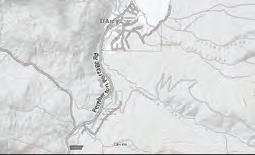
Take notice that we, William and Eileen Pietila, from Devine, BC, have applied to the British Colum‐bia Ministry of Water, Land and Resource Stewardship (WLRS), South Coast Region for a roadway tenure to access private land situ‐ated on Provincial Crown land lo‐cated at 9580B Pember ton Portage Road.
Comments concerning this appli‐cation should be directed to the Senior Land Officer, South Coast Region, Ministry of Water Land and Resource Stewardship (WLRS), at Suite 200, 10428 153rd Street, Surrey, BC, V3R 1E1. Comments will be received by WLRS up to October 24th, 2025. WLRS may not be able to consider comments received after this date. Please visit the Applica‐tions, Comments and Reasons for Decision Database website at http://comment.nrs.gov.bc.ca/ for more infor mation.
Be advised that any response to this adver tisement will be consid‐ered part of the public record. Ac‐cess to these records requires the submission of a Freedom of Infor‐mation (FOI) request. Visit http:// www.gov.bc.ca/freedomofinform ation to learn more about FOI sub‐missions.


Available November 15, 2025 for a 1 to 5 year lease.
Location: Bayshore
Upper Unit: 4 bedrooms, 2 bathrooms.
Total 9 tenants.
Lower Unit: 2 bedroom, 1 bathroom.
Total 4 tenants
Parking: Two surface parking spots.
Rental Rate: At current market rates, call or email for exact rates.
Please email for more photos.
Fully fur nished: beds, large & small appliances (2 fridges), all linen, pillows, comforters, towels, dishes, pots & pans, couch, 55” flat screen TV, etc… 604-700-4290 or kitscondos@ gmail.com



BUILDINGOURCOMMUNITY




EmployeeHealth&WellnessPlanavailable
HEAVYEQUIPMENTOPERATOR– Minimum 5yearsor5,000hoursoperatingexperience onexcavator. Full-time,Monday –Friday.$33-$46perhour.
CRUSHING &EARTHWORKSMANAGER– Musthaveexperiencewithmobilecrushingplantandheavy civilconstruction.$33-$46perhour.
CONSTRUCTIONLABOURER– Greatopportunitytolear non-the-job.Staminaforphysically demandingworkandperseverancetobraveinclementweather required. Previousexperiencepreferredbutnot required. Trainingprovided.$28-$33perhour.
PIPELAYER –Minimum 5yearsexperienceincivilconstruction.
Full-time,Monday –Friday.$33-$43perhour.
TRUCKDRIVER –BCDLClass 1orClass 3withairbrakesrequired.Manualtransmission. 2yearsexperiencepreferred.$35-$41.50perhour.
WELDER– RedSealorequivalent.$40.19-$49.15perhour.
PROJECTCOORDINATOR– Minimum2 yearsexperiencepreferred.$29-$40perhour.

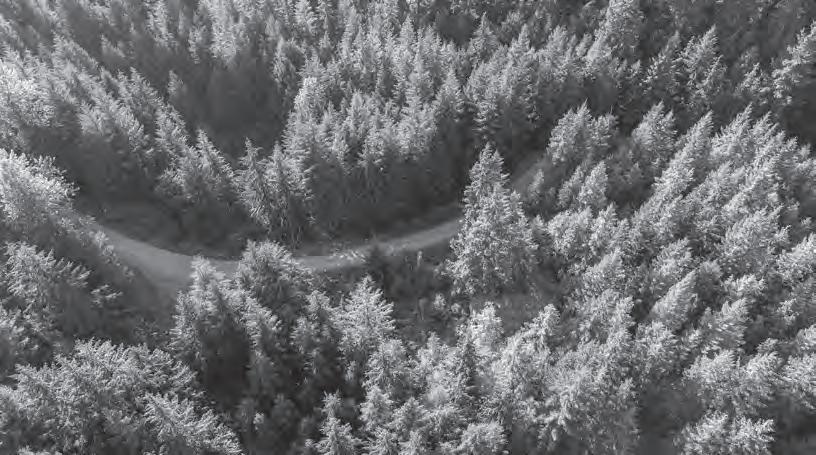



CareerOpportunities withtheSLRD
Lookingtocontributetoyourlocalcommunity?
Consider acareerinlocalgovernment?
JointheSLRD’steamofdedicatedstaffwhoworktogethertomakea differenceintheregion.
HeadquarteredinPemberton,theSquamish-LillooetRegionalDistrict(SLRD) deliversa widerangeofregional,sub-regionalandlocalservicestoitsresidents. TheSLRDisa BCRegionalDistrictconsistingoffourmembermunicipalities (Squamish,Whistler,Pemberton,Lillooet)andfourelectoralareas.Services includelanduseplanning,solidwastemanagement,buildinginspection,fire protection,emergencypreparedness,911services,recreation,waterandsewer utilities,regionaltransit,trailsandopenspacesaswellasfinancialsupportfor variouscommunityservices.
Applicationsarecurrentlybeingacceptedforthefollowingpositions:
• Planner(Temporary,Full-time) payrange$93,690- $105,449/yr Closingdate:September14,2025
• FireServicesManager(Regular,Full-time) payrange$104,978 -$118,154/yr
ClosingDate:September21,2025
TheSLRDoffersa competitivecompensationandbenefitspackage,a compressed work week(nine-dayfortnight), hybridremote work ar rangements, andlearning and careerdevelopmentopportunities. Formoreinformationonthesecareeropportunities, pleasevisit www.slrd.bc.ca/employment.Toapply, pleasesubmit acoverletterandresume (preferablyinpdfformat) by emailto careers@slrd.bc.ca.
Wesincerelythankallapplicantsfortheirinterest,however,onlythose shortlistedwillbecontacted.



ÚlÍusCommunityCentre
•Receptionist($17.85-$20.90perhour)
•HumanResourcesGeneralist($57,330.00to$64,610.00peryear)
Child&FamilyServices
•AssistantDirector,Child&FamilyServices($93,475.00to $101,556.00peryear)
• TransitionHouseSupport Worker($20.90to$29.45perhour)
Lil’watHealth&Healing+PqusnalhcwHealthCentre
•HealingProgramManager($57,330.00to$64,610.00peryear)
•ProgramCoordinator($46,683.00to$63,973.00peryear)
•AssistantDirector,Health& Wellness($93,475.20to$101,566.00 peryear)
•CommunityHealthNurse($41.42to52.81perhour)+$2.15 hourlypremium)
CommunityProgram
•EarlyChildhoodEducator-Infant Toddler($24.00-$29.45/hr basedonexperience+thispositioniseligibleforwagetopup)
Xet’òlacwCommunitySchool
•EducationAssistant($20.90to$29.45perhour)
•LanguageResource WorkerorLanguage Teacher($46,683to $109,520peryear)
Ts’zilLearningCentre
•IndigenousSupport Worker($38,038to$53,599peryear)
•IndigenousSupport Worker–Academic($38,038to$53,599 peryear)
Pleasevisitourcareerpageformoreinformation:https://lilwat.ca/careers/

GeneralContractorwithworklocationsinWhistler& Pembertonperforminghigh-endcustomrenovations andnewresidentialand commercialbuilds. Hiringforthefollowingpositions:
Labourer -previousconstructionexperiencepreferablebut notrequired,abilitytoperformphysicalwork,positive attitude,greatsmile$30p/h+
ApprenticeCarpenter - ownvehicleandbasictools,ability totakedirectionwithastrong attentiontodetail,team player,hardworker,funtobearound$35p/h+
Payratesforallpositionsdependsonexperience.Regular performance-basedpayreviews.
Ifyou’dliketobepartofanhonest,hard-working, andfunteamthat appreciatesitsemployees, emailusyourresumetoday!

admin@tiedemancustomconstruction.com





PositionOverview: Providesadministrative support to theJordan's PrincipleServiceCoordinator,Service Coordinationdelivery, andsupport communitybuildingactivitiesasneeded.Disseminate informationtothe publicandtoservice providersand community-basedprofessionalsto promote Jordan'sPrincipleand reduce servicebarriersforIndigenous childreninBC.
Qualifications:
•Excellent verbalandwritten communicationskills
•Workeffectivelywith FirstNations communities andpeople
•Abilitytowork independentlyandin teams



•Demonstratedabilityto maintain confidentiality, privacyandsecurity ofinformation
•Excellent attentionto detail,organizationalskills, andtimemanagement
•Satisfy requirements fora Criminal Record Checkand VulnerableSectorCheck
Seefulljobposting: sshs.ca/careers/
Applybysendingyour resumeandcoverletterto: julia.schneider@sshs.ca
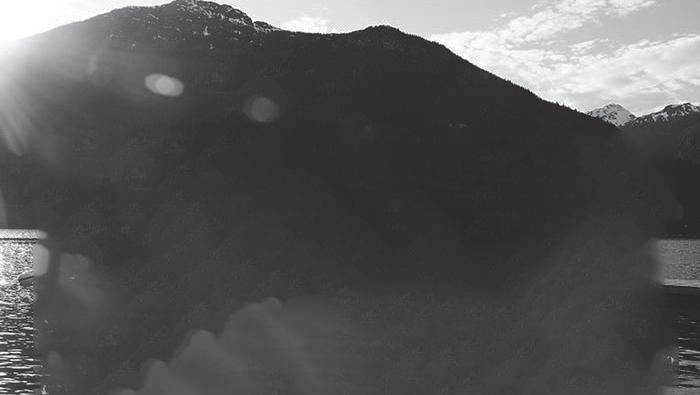


Dutiesinclude:
•PromotingJordan'sPrincipleand reducingbarriers forIndigenous childreninBC.
•Buildingrelationshipswith stakeholders,including governmentandFirst Nations.
•Coordinatingpaymentsfor approved requestsperISCand SSHSguidelines.
•CollaboratingwithISC,service providers,andIndigenousfamilies to promoteand coordinate Jordan'sPrincipleservices.
•Maintaining adatabaseof requestsandpayments, preparingfunder reportswith leadershipandfinance.
•Providingfinancialsupport, developing,andimplementing paymentsystemsandprocesses.
Special:
•Thispositionisrequirestravelto indigenous communitiesserved by SSHS,accessedbyForest ServiceRoad
•SSHSoffersa competitive benefitsandemployment packagetofulltimeemployees



















Hello, fascism!
AS ADVERTISED, it’s finally here. In all its full-blown peril, with trampled rights, extrajudicial kidnappings, military deployments, risible misdirection from scandal, and levels of kleptocracy, kakistocracy, hypocrisy and doublespeak that George Orwell could not have even imagined.

BY LESLIE ANTHONY
For the damaged, deluded and/or deranged North Americans who’ve awaited this tectonic pathology with bated breath, congratulations on celebrating the sudden usurping of a half-century of hard-won social, health, scientific, educational and environmental progress in America, gone with the wave of a puppet madman’s pen. You must be so proud. Unless you are somehow affected, of course, in which case your enthusiasm is doubtless tempered as you sort through the bewildering mental conflicts of having so many “I-told-you-sos” come true at once—unexpectedly from your perspective, one imagines, but more than inevitably from the rest of us.
Yes, the rest of us—a vast majority, actually—for whom, at least in the Great White North, advent of such a catastrophe in our backyard is indeed horrific to watch unfold, particularly when our tut-tutting is no aid to American friends suffering grotesquely now and into the foreseeable future under the malign dictates of a shockingly pervasive christofascism that any thinking person— particularly if they’d witnessed its beginnings in the Reagan era, or recognized aspirational
factions under George W. Bush—has seen coming for decades.
No need to revisit all of that, but like the invasive plants growing in a neighbour’s yard that they refuse to control, we know it won’t be long before this vine, too, creeps into Canada. Indeed, the seeds have already blown in and rhizomes burrowed under the fence, sprouts germinating in our own political soils bit by bit.
Alberta, with its Luddite United Conservative Party premier, is most heavily compromised, with an American-style, gaslight-driven war on health-care, science, wildlife, environment, parks and education— the latter including a Florida-esque book banning that makes Ray Bradbury’s Fahrenheit 451 seem like an academic risk assessment. Saskatchewan isn’t far behind, Ontario riding the back of the train but still in need of watching. New Brunswick managed to turn the tide in a great big Bay-of-Fundy way but threats remain in its rural reaches.
To this point, creeping ignorance of this big-picture danger among the short-
where the writer usually posits a grand tour of How did we get here? I won’t, however, because I’ve already written that column numerous times—with people writing letters to the editor on each occasion decrying my making of such scholarly observations or martialling the readily available data to support them. That’s because stans of far-right conservatism, entrenched in their ideals and perceived moral superiority, fail to recognize the authoritarian—and by relation, fascist— tendencies inherent in these.
It’s a slippery slope, as I’ve often noted. But it can be seen in how much of the modern conservative agenda is sheer laziness candy-coated as action—along with the gleeful but truly unconscious use of the misinformation machine that supports it. In this model, the complex, nuance-filled grey areas of government policy in need of constant attention, adjustment, adaptation and improvement—think immigration, housing, human rights, drug use, energy, defense, trade, government efficiency—are reduced to a black-and-white for which all solutions are
Ignorance. Selfishness. Entitlement. Noninvolvement and willingness to look the other way when wrongs are clearly occurring. This is how fascism has always taken root.
term thinking Canadian electorate (i.e., conservatives) has been managed by the levers of a much-healthier and more charitable democracy than the U.S. enjoys—which, it should be noted, is less an actual democracy every day in the eyes of the global community and organizations like Democracy Watch, which listed it within months of its current leader taking office—right around the time the first round of “Is He Dead Yet?” T-shirts went on sale.
This is the point in a column like this
binary. The reality is that dealing with these things takes a ton of work and a lot of time, and cannot be fixed with an on-off switch. As exemplified in the American approach, conservatives simply can’t imagine doing this work, and so prefer the proverbial grenade to address tractable problems when a few wellplaced bullets—and effort—would do.
A good domestic example is Pierre Poilievre’s recent performative suggestion of completely shuttering the Temporary Foreign Worker program (which, quite
ironically, he and previous boss Stephen Harper turbocharged)—a pronouncement immediately and happily derided as nonsense by even the Canadian business community—a grenade toss based on false information, false declarations, and false imagined outcomes. Does the program need to be modified to become more agile and responsive to changing needs? Of course. Does it need to be shut down? Of course not.
But the outrage engendered by something so small immediately diverts the gaze from the fascist leitmotif behind it, disrupting vigilance. And so now back to how we got here, whose many detailed explanations by myself and others involve not just conservatives, but all of us, and can be summed thus: Complacency. Ignorance. Selfishness. Entitlement. Noninvolvement and willingness to look the other way when wrongs are clearly occurring. This is how fascism has always taken root. As someone put it on Facebook months ago, presciently observing that the U.S. administration wasn’t debating the facts but erasing them, “They never kick down the door first. That’s the mistake we always make in the stories we tell ourselves. That tyranny will arrive in jackboots and bayonets, that we’ll hear it coming, that we’ll know. But it never starts with force. It starts with forgetting.”
The fact that we are now at the jackbootand-bayonet stage means we have already forgotten, so perhaps the best lesson for both Americans and Canadians in general, and not-yet-fascist-adjacent conservatives in particular, is to remember this: although 1930s Germany offers hefty warning to the world community about the domestic and imperialist dangers of fascist dictators and whose state machinery now works diligently at the broader aims of European democracy, we often forget one important aspect of that history—theirs was the first country the Nazis invaded.
Leslie Anthony is a science/environment writer and author who holds a doctorate in reversing political spin.

4

$4,599,000 604-935-0700 Janet Brown janet.brown@evrealestate.com

3366 Lakeside Road, Whistler
3 Bed | 3 Bath | 2,327 sq.ft.


$3,395,000 604-938-3815
Ron Mitchell PREC* & Rachel Allen ron@resortwhistler.com R&R Group

3

$1,699,000 604-902-3335
Steve Legge PREC* steve.legge@evrealestate.com

4
$5,899,000


maggi.thornhill@evrealestate.com










